Creative Resources for ESL/EFL Teachers


ESL Presentation Topics: 12 Mini Presentations
ESL presentation topics for intermediate and upper intermediate students. Great as a warm-up or a speaking lesson.
You can use the slideshow and share your screen on Zoom or other app when teaching online. Just click on the full screen option in the top right corner of the slideshow.
I used it with my students during our online lesson and we didn’t even have time to discuss all the topics, because they couldn’t stop talking. I was quite impressed how much they knew and also how well they could express their opinions.
One of the reasons why I love conversation activities is that I learn so much about my students. I think that we often underestimate our students and see them as the stereotypical lazy teenagers. Activities like these can show us that they are much more than that.
You can also download the PDF for easy printing below.
Other picture-based resources:
ESL Exam Speaking Picture Description and Questions
No-Prep ESL Picture Description Speaking Activity
Picture Based Speaking Activity For ESL/EFL Classes
Picture Prompts for Speaking and Writing: An ESL Activity
ESL Picture Description: Exam Skills Practice
Food and Travel ESL Lesson: Interactive Online Lesson
Conversation resources:
Popular Conversation Topics for (not only) Adults and Teenagers: 50 Questions
Conversation Starters: 30 Interesting Conversation Questions Not Only For ESL Students
Conversation Questions Gerunds and Infinitives: ESL Speaking Activity
30 Hypothetical Conversation Questions for ESL Students
ESL Conversation Topics

Related Posts

Ridiculous Holiday Complaints: Reading And Speaking(Role-play) ESL Lesson Plan
Holiday complaints: An engaging ESL activity promoting reading and speaking.

ESL Teaching Idea: Class Speaking Activity
Engaging speaking activity for upper intermediate and advanced students.

ESL Taboo Cards: Printable Vocabulary Activity
Are you looking for a stimulating and entertaining method to increase your vocabulary and communication abilities in English? Take a look our ESL taboo card games below! ESL Taboo is a frequently played game that’s designed for teams of two or more players. The goal is to get your teammates…
Comments (7)
- Pingback: 50 ESL Conversation Questions for Teenagers and Adults | EFL Ideas
- Pingback: ESL icebreakers, warm ups, back to school activities and more | EFL Ideas
- Pingback: Phrasal Verbs Activity Exercises Discussion Questions | EFL Ideas
- Pingback: Conversation Topics for (not only) Adults: 5o Questions - EFL Ideas
- Pingback: Conversation Starters: 30 Interesting Conversation Questions - EFL Ideas
- Pingback: Back to School Activities ESL for ESL Classes- EFL Ideas
Amazing! Thanks a lot
Leave a Reply Cancel reply
Your email address will not be published. Required fields are marked *
Save my name, email, and website in this browser for the next time I comment.
This site uses Akismet to reduce spam. Learn how your comment data is processed .
ESL Speaking
Games + Activities to Try Out Today!
in Activities for Adults
Presentation Projects for Students | ESL Presentation Ideas
If you do presentation with your language classes , then you’ll need to check out some of these presentation project ideas. Get beyond the boring old PowerPoint presentation and use some of these creative ideas to bring a bit of excitement and life back into your classes.

Presentation Projects and Ideas for ESL students
Your students will love it, and it’ll also keep things fresh for you if you’ve seen the same old projects year after year.
Presentation Projects for ESL/EFL Students
Over the years teaching in a Korean university , I’ve had students do plenty of presentation projects, with varying degrees of success . I hope that you can learn from my mistakes and make your ESL speaking classes as awesome as possible.
Presentation projects, if set up well are an excellent way to add a bit of variety to the ESL classroom. After all, students get tired of hearing the teacher talk all the time! And you probably get tired of talking. I know that I always did! Plus, it’s fun to hear what students have to say.
Here are my top presentation projects for ESL/EFL students.
- Basic speech (not recommended!)
- Presentation, then discussion time
- Poster presentation
- Making a movie
- PowerPoint presentation
- Impromptu presentation
- Teaching the class how to do something
If you teach business English, then the sky is kind of the limit in terms of what topics you choose. You could focus on just about anything that students may expect to present on when they start working in a company.
#1: A Basic Speech
Each student has to choose from a variety of topics such as family , food, dreams or hobby. They have to speak for between 1.5 and 2 minutes. I did this only once, with low-level students and it was ridiculously boring such that I never did it again.
The main problem is all the presentations are basically the same and go a little something like this: “I have a mom. She is 49 years old. She has brown hair and black eyes. I have a dad. He is 57 years old. My dad has brown hair and black eyes. He is short.” Word for word, almost the same!
Trust me, they were some of the most tedious and excruciating hours of my entire life. It was from this point on that I vowed to never set up a presentation like this again. I got a lot more creative and made students talk about things that were more varied and interesting.
Of course, the bad results from this experiment were totally my fault. I should have chosen more interesting topics for the students, or given them better guidelines. Seriously, better ESL presentations topics would have made a big difference here and I really have nobody to blame but myself!
Maybe Not Terrible if…
This style of presentation could have been far less bad if I had done a better job setting it up. I should have set the topic to something like, “Current events.” That way, students would have been forced to choose something in the news and the presentation topics would have been quite varied.
Or, I could have required some visual aids to make it a bit more interesting for the students.

#2: Presentation, and then Discussion Time
Each group has to give a presentation about a topic of their choosing and think of at least 5 interesting questions/surveys/activities that groups could discuss or do for about 20 minutes after their presentation. This often works best if the presentation is based on 2-3 articles that the students have to send you in advance.
This presentation project ideas had varying results, since some groups chose a topic that led to a lot of “yes/no” answers and discussions that lasted about 5 minutes, at most.
However, this could have been avoided by personally approving the topics in advance and requiring groups to submit their assignment for feedback a week or two before the actual presentation. I blame nobody but myself for the failure on this one!
This ideas for presentation projects isn’t a bad one, if you set it up well. It can work well for English majors or advanced level students who want a class filled with conversation and discussion.
#3: Poster Presentation
A poster is one of my favourite presentation projects. Each group has to choose a current controversial issue (like environmental pollution, suicide, North Korea) and make a poster that had English writing and some interesting pictures on it. Set a (low) max number of words or your posters will be terrible and filled with wordy death!
Then, the students have to do a presentation based on the poster where each group member speaks for 1-2 minutes, without a paper.
For this one, it’s very important that you require no paper script, or you’ll just have students reading off their notes. Also, don’t allow students to put too many words on the poster, or you’ll have students reading off of this.
If I ever did this again, I would do something where the audience was more involved, such as peer grading. Or, I would require each group watching the presentation to think of at least 1 question to ask and they’d get a point for doing so. Basically, it’d give the rest of the students in the class a reason to listen.
It’s potentially an excellent group presentation project!
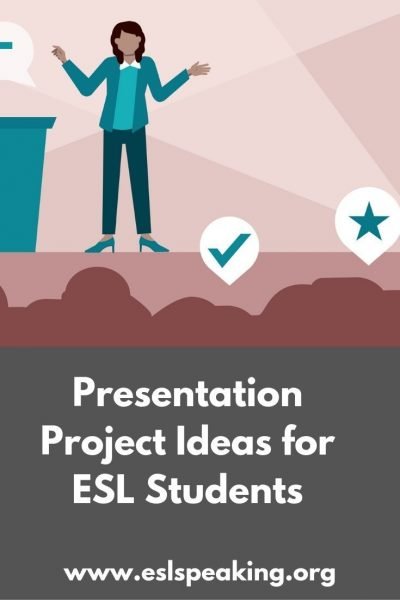
ESL presentation ideas
#4 Presentation Projects: Making a Movie
Another ESL presentation idea is to have students make a movie. It’s easier than ever these days because almost everybody has a smartphone, and it’s free to upload the video to YouTube. This works particularly well if you teach film, art or fashion students and you’ll get some amazing results. It’s actually one of my favourite ESL projects these days.
You can have a fun “viewing day” in class and encourage everyone to bring a snack! It’s a nice change from the regular old textbook thing.
Here’s how I’ve done movie projects.
- I put students into groups of 4-5. One person can “film” the project and then you can have 2-3 actors. Finally, one person might be designated the write the script or edit. However, I leave it up to the group how they want to divide the roles and not everyone has to appear on camera.
- I set a minimum and maximum time for the movie (usually 3-5 minutes), as well as a certain number of English sentences that must be spoken during that time. It must be a story of some kind that makes sense.
- I’ll usually give a topic or theme of some kind, but may leave it open.
I evaluate it based on the following things:
- Quality of English
- Interesting story
- Quality of production (I don’t expect a lot, but just basic stuff like making sure it’s bright enough, we can hear the people talking, etc.)
The quality of English usually gets around 10 marks, while the other two categorie s are each worth five.
#5: PowerPoint Presentation
This has the potential to be very interesting, or PPT death. It all depends on how you set the presentation project up.
If you do go with this method, you should set a maximum number of slides and also a maximum numbers of words per slide (5-10?). Emphasize to students that you want to see pictures, charts, etc. and not a wall of text.
I generally allow each group to have 1 intro and 1 conclusion slide, and then 1 slide per group member. So if there are 6 students in the group, it’ll be 8 slides. I usually say that each student has to talk about their slide for 30 seconds to 2 minutes, depending on the level.
Teach students how to make good PowerPoints and then penalize heavily for not following your recommendations. You should also coach students on how to stand to the side and keep their body pointed towards the audience. Eye contact is key!
This is an excellent idea for presentation projects, if some key expectations are set out in advance. Eye contact/don’t look at screen, pictures instead of words on the PowerPoint, etc.
#6: Just a Minute Impromptu Presentation
If you want to give your students some practice with making impromptu, or off the cuff style of speeches, then Just a Minute may be exactly what you need. It’s a toastmasters style activity and makes the perfect warm-up activity for intermediate or advanced level students.
You can also turn this into a listening activity, instead of just an ESL presentation by requiring the other students in the group to ask follow-up questions. Try this one with your classes and I think your students will really enjoy the challenge.
Find out more about it here:
Just a Minute ESL Speaking Activity
Impromptu presentation skills are never a bad thing for students (or anyone) to practice!
#7: Teaching Others How to Do Something
One of the best presentation ideas for students is to get them to teach the class how to do something. I’ve done this a few times now and they are some of my most memorable classes.
The way it works is that students choose something they know how to do well. Students in the past having chosen things like:
- How to fry an egg
- Heading a soccer ball
- Playing the guitar
- Getting dates
- Making sure their parents give them enough spending money
- Eating out cheaply around the university
- Getting the best class schedule
I allow students to bring in props, material or make a simple powerpoint presentation with pictures (no text) to explain.
#8: What are you Cooking?
If you want to have your students do some fun presentations in a more informal kind of way, then consider trying out “What are you Cooking?” Students have to plan a 3-course meal based on ingredients from their classmates and then make a presentation to the class who votes on the best menu.
Sounds interesting? I think you’ll love it so give it a try today. More information here: What are you Cooking?
#9: An Informative Speech
ESL Presentations FAQs
There are a number of common questions that people have about making presentation in English. Here are the answers to some of the most popular ones.
Why are Presentations Important for Students?
Having students give presentations is important for delivering a positive learning environment. They can also help teach communication skills and assist with students feeling comfortable talking in front of a group of people. Finally, they are an engaging way to share ideas and help students build confidence.
What Makes a Great Presentation?
A great presentation is very memorable. This can be done in various ways, but graphics, images, relevant facts, story telling and humour play an important role. Finally, a memorable presentation motivates the audience to action.
What are the Advantages of a Presentation?
Businesses and people in general use presentations for various reasons. The advantage of them is that they can educate, motivate, and persuade in a more interesting way than the written word alone can.
Should Students Memorize Speeches?
Should you make students memorize their presentation, or not? It’s an interesting question and I certainly see points for both sides. However, I generally lead towards the memorization thing because…
- It results in presentations that are far more interesting for the audience
- I only require 30 seconds-2 minutes of speaking. It’s not a big task to memorize this amount
- It helps students remember vocabulary and key phrases
That said, I do know that students get nervous and that this can be a big ask. It’s for this reason that I tell students to bring their notes up to the front with this, but to leave them in their pocket.
If they have an emergency (forget what to say!), they can take it out and use it. But, only once if they don’t want to get a penalty. After that, put it aside and continue on.
I’m usually kind and if a student has to do this twice, I don’t mind. My main point is that I don’t want students reading exclusively off of a paper.
What are some Things to Consider for Presentations in English?
If you’re going to have your students do an ESL presentation, there are a number of factors that you’ll want to consider.
- How to explain the task in a simple way that students can understand what they need to do. How will you evaluate it?
- When will students prepare (outside, or inside of class. A combination of both often works well).
- What kind of equipment can students use (Projector, or not).
- How students will deliver the presentation. Will you expect things like gestures and eye contact?
- What kind of language will the students use? Will you teach them about the introduction (I would like to start by…) and conclusion (In conclusion, you can see that…), as well as transition sentences (Moving on to…). The style of the speech (persuasive, informative, etc.) is important for this.
- What will the rest of the class be doing while the presentations are happening? Is there a listening task you can assign to make this activity even more valuable?
The biggest tip I can give you is to be clear about the terms of the assignment. And, also how you will evaluate it. If expectations are clear, results will be far better and your life will be easier as well because you won’t have to answer the same questions over and over again.
What are the Top 20 ESL Presentation Topics?
Here are some of the most common topics that you may consider assigning to your students:
- Family (can be sensitive for some though)
- Current events
- If I had a million dollars…
- Vacation (past or future dream)
- Ideal first date
- TV and movies
- Favourite book
- Time, and how do you spend it
- An ideal first date
- Jobs and work
- Some future goals
- A favourite restaurant
- Money (saver or spender)
- Future plans
- Controversial topics
- Teaching someone how to do something
- If you were the president…
These interesting topics means that you presentation projects will be better than ever! No more boring, okay? Okay.
Do you Like these Ideas for Presentation Projects?

- Amazon Kindle Edition
- Bolen, Jackie (Author)
- English (Publication Language)
- 148 Pages - 03/09/2016 (Publication Date)
Then you’re going to love this book, 101 ESL Activities: For Teenagers and Adults . It’s an extremely practical, well-organized teaching guide that will help you plan your lessons in no time. The best part about it is that your students will be having fun, while learning English.
The book is available in both digital and print formats. The (cheaper!) digital one can be read on any device-Kindle, Mac, Pc, Smartphone, or tablet by downloading the free Kindle reading app from Amazon. It’s super-easy to have some top-quality ESL activities and games at your fingertips at all times.
Keep a copy on the bookshelf in your office and use it as a handy reference guide. Or, bring a copy with your on your phone or tablet to your favourite coffee shop for lesson planning on the go. It really is that easy to make your English classes even better.
Check out the book on Amazon by clicking the link below:
Have your Say about ESL Presentation Ideas
What’s your top ESL presentation project ideas? Leave a comment below and let us know what you think. We’d love to hear from you.
Also be sure to give this a share on Facebook, Twitter, or Pinterest. It’ll help other teachers, like yourself find this useful teaching resource.
Last update on 2024-04-14 / Affiliate links / Images from Amazon Product Advertising API
About Jackie
Jackie Bolen has been teaching English for more than 15 years to students in South Korea and Canada. She's taught all ages, levels and kinds of TEFL classes. She holds an MA degree, along with the Celta and Delta English teaching certifications.
Jackie is the author of more than 100 books for English teachers and English learners, including 101 ESL Activities for Teenagers and Adults and 1001 English Expressions and Phrases . She loves to share her ESL games, activities, teaching tips, and more with other teachers throughout the world.
You can find her on social media at: YouTube Facebook TikTok Pinterest Instagram
Great ideas! Thank you so much for such inspiring ideas for presentations.
I’ve been looking for some presentation ideas for my students here in South Korea and ran across your list. Thank you! Lots of good ones but I think I’m going to give the current events one a try. I’ll let you know how it goes.
Great info! Thanks for sharing your ideas for presentations. I love to do them but it was getting a bit stale for me so appreciate the new ideas.
Leave a Reply Cancel reply
Your email address will not be published. Required fields are marked *
Our Top-Seller

As an Amazon Associate, I earn from qualifying purchases.
More ESL Activities

What are Silent Letter Words and Common Examples
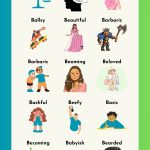
B Adjectives List | Describing Words that Start with B
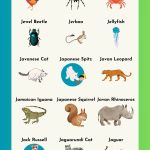
Animal Names: Animals that Start with the Letter J

How to Write Your Own Story in 5 Simple Steps
About, contact, privacy policy.
Jackie Bolen has been talking ESL speaking since 2014 and the goal is to bring you the best recommendations for English conversation games, activities, lesson plans and more. It’s your go-to source for everything TEFL!
About and Contact for ESL Speaking .
Privacy Policy and Terms of Use .
Email: [email protected]
Address: 2436 Kelly Ave, Port Coquitlam, Canada
20 Presentation Tips for Your ESL Students
Helping learners to give presentations is an excellent way to encourage fluency. For some of your students, the ability to give a good presentation in English may be mandatory for their jobs. Here are twenty tips to help ensure a successful presentation, from beginning to end. Who knows? You may find them useful too.
- Allow plenty of time for preparation.
- Answer the all-important question-words: why? who? where? when? how? and what?.
- Structure your presentation into introduction, body, conclusion and questions.
- Write notes based on keywords.
- Rehearse your presentation several times and modify it as necessary.
- Select the right equipment for the job.
- Use your equipment effectively.
- Make use of clear, powerful visual aids that do not overload your audience.
- Use clear, simple language, avoiding jargon.
- Use active verbs and concrete facts.
- Explain the structure of your presentation at the beginning so that your listeners know what to expect.
- Link each section of your presentation.
- Signpost your presentation from beginning to end so that your listeners know where they are.
- Overcome your nerves.
- Establish audience rapport.
- Be aware of your body language.
- Understand cultural differences.
- Maintain interest by varying the speed, volume and pitch of your voice.
- Deal with listeners’ questions politely.
- Respond to your audience positively.
These tips are condensed from Presentations in English .
You may also like:
- Listen&Learn: How 3D Printers Work
- Listen&Learn: The Lord of the Rings
- 5 Ideas for Teaching English One-on-One
Leave a comment
Email * (not published)

Free ESL PowerPoint Lessons To Teach English
Download FREE ESL PowerPoint lessons and use them in class today. These PowerPoint lessons are great to use in lessons teaching English to English language learners. You’ll find vocabulary PowerPoints, grammar PowerPoints, seasonal grammar points, phonics PowerPoints, and more presentations covering the topics that ESL students typically study.
ESL PowerPoint Lessons
Browse through all our ESL PowerPoint lessons below.
- 2D Shapes PowerPoint
- 3D Shapes PowerPoint
- Action Verbs PowerPoint
- Animals PowerPoint
- Big And Small PowerPoint
- Body Parts PowerPoint
- Christmas PowerPoint
- Classroom Objects PowerPoint
- Clothes PowerPoint
- Colors PowerPoint
- Comparative Adjectives PowerPoint
- Daily Routine PowerPoint
- Describing Appearance PowerPoint
- Directions PowerPoint
- Fall/Autumn PowerPoint
- Family Members PowerPoint
- Farm Animals PowerPoint
- Feelings And Emotions PowerPoint
- Five Senses PowerPoint
- Food PowerPoint
- Fruits PowerPoint
- Halloween PowerPoint
- Hobbies PowerPoint
- Homophones PowerPoint
- How Much Is It? PowerPoint
- Jobs And Occupations PowerPoint
- Natural Disasters PowerPoint
- Nature PowerPoint
- Nouns PowerPoint
- Numbers PowerPoint
- Onomatopoeia PowerPoint
- Opposite Words PowerPoint
- Ordinal Numbers PowerPoint
- Pet Animals PowerPoint
- Places Around Town PowerPoint
- Prepositions Of Place PowerPoint
- Present Progressive PowerPoint
- Present Simple PowerPoint
- Rooms Of The House PowerPoint
- School Subjects PowerPoint
- Sea Animals PowerPoint
- Seasons PowerPoint
- Sickness and Health PowerPoint
- Sports PowerPoint
- Spring Vocabulary PowerPoint
- Superlative Adjectives PowerPoint
- Telling The Time PowerPoint
- There Is There Are PowerPoint
- Toys PowerPoint
- Transportation PowerPoint
- Vegetables PowerPoint
- Weather PowerPoint
- Wh Questions PowerPoint
- Winter Clothes PowerPoint
- Winter Sports PowerPoint
More Resources
You can find many more free ESL resources on Games4esl. Check out our free PowerPoint Games , Activity Videos , Online Quizzes , Worksheets , and ESL Printables .
Presentory for Windows
Presentory for mac, presentory online.
Rebrand your approach to conveying ideas.
Differentiate your classroom and engage everyone with the power of AI.
Knowledge Sharing
Create inspiring, fun, and meaningful hybrid learning experiences
Create with AI
- AI Tools Tips
Presentation Ideas
- Presentation Topics
- Presentation Elements
- Presentation Software
- PowerPoint Tips
Presentation Templates
- Template Sites
- Template Themes
- Design Ideas
Use Presentory Better
- Creator Hub
More Details
- Basic Knowledge
- Creative Skills
- Inspirational Ideas
Find More Answers
- LOG IN SIGN UP FOR FREE
- Full Guide About Best ESL Presentation Topics for Students
- 10 Unique PowerPoint Design Ideas to Captivate Your Audience
- Mastering Business Presentation Skills for Success (Innovative Business Presentation Ideas Updated)
- Creative 8 New Year Presentation Ideas with PowerPoint Themes
- Crafting an Effective PowerPoint Front Page Design for Maximum Impact
- Mastering PESTEL Analysis with PowerPoint: Guide and Templates
- Highlighting The Important Components of Real Estate PowerPoint and How to Make One
- Designing A Sales Plan Presentation for PowerPoint - An Overview of All Details
- Best Presentation Themes to Engage Your Audience in 2023
- Best Presentation Topics for Engineering Students
- 5 Engaging Presentation Topics for University Students
- 10 Interesting Presentation Topics for Students That Will Help You Shine
- Intriguing Topics for Engaging Computer Science Presentations
- Best 10 Selected Current Topics for Presentation to All Audience
- Hot Paper Presentation Topics For CSE
- Elevate Your Skills: Best Topics for Presentation in English
- Top MBA Presentation Ideas To Elevate Your MBA Education
- A Complete Guide to Create Company Profile PowerPoint Presentation With Templates
When you choose ESL presentation topics your students are passionate about, you set them up for success. They'll be more engaged in learning and more likely to retain the information you're teaching. So, how do you choose the proper ESL presentation topics for your students?
Choose topics you know will spark their curiosity and inspire their interest in learning. At the end of this article, you'll learn an easy-to-use presentation maker to help with your virtual lessons. Keep reading if you want to learn more about ESL topics and ideas.
In this article
- What Types of ESL Presentation Topics Are You in Search Of?
- How To Prepare Your ESL Presentation?
- 5 Best ESL Presentation Topics for All Students
- Best Tool for Your ESL Presentation – Wondershare Presentory

Part 1. What Types of ESL Presentation Topics Are You in Search Of?
What's the secret to giving an ESL presentation that will keep your audience hooked? Flexibility. Also, tailor your topics to the student's proficiency level, interests, and learning objectives. Spark your students' curiosity with these engaging ESL presentation topics .
This category covers everyday activities, routines, and personal experiences. Daily life topics are often a good choice for beginners, as they tend to be familiar and easy to relate to.
Travel and Culture
Explore different countries, customs, and traditions. Students can present their dream destinations, cultural celebrations, or travel experiences. ESL presentation topics like this promote geography, tourism, and cross-cultural understanding.
Discuss the ever-evolving world of technology, from smartphones to social media trends. Students can discuss gadgets, apps, or the impact of technology on society, fostering language skills in a modern context.
Environmental Issues
Raise awareness about environmental concerns like climate change, pollution, and conservation. Students can propose solutions or discuss the importance of sustainable practices.
Current Events
Encourage students to share their views on global happenings. Ask open-ended questions to provoke students' critical thinking about the news. Avoid asking your students subjects that have a simple yes or no answer.

Literature and Arts
Explore the world of literature, art, and entertainment. Students can discuss their favorite books, movies, or artistic movements.
History and Politics
Delve into historical events, political systems, and influential figures. These ESL presentation topics encourage critical thinking and cultural awareness.
Food and Cuisine
Food is a universal language. It brings people from all walks of life to share experiences and create memories. And what better way to learn about others' culture than through their cuisines? Students can share their passion for food and cooking and express their unique cultural identity.
Part 2. How To Prepare Your ESL Presentation?
If you have chosen presentation topics for ESL students , it is time to start preparing. Here's a simple, three-step guide to help you deliver effective ESL presentations:

Use Data and Infographics for Less Content
Short attention-spanned students and visual learners often struggle with processing lengthy textual information. Using data and infographics becomes even more crucial in such cases. You can include charts, graphs, diagrams, and other visual elements that help to illustrate key points. Then, choose relevant statistics or facts that support your topic. Visual aids can capture attention and maintain their engagement throughout the presentation.
Make an Outline for Your ESL Presentation
Creating a clear outline is essential for maintaining the flow. Start with an engaging opening to attract your students' attention. Then, organize your content logically into sections or points. Use bullet points or numbered lists to keep information organized and easy to follow.
Practice Before Presentation
Rehearse your presentation multiple times, focusing on your pacing, pronunciation, and overall delivery. If possible, present in front of a friend or colleague for feedback. It will boost your confidence and help you address any areas that need improvement. Remember, the more you practice, the more comfortable you'll be when delivering ESL presentation topics to your students.
Part 3. 5 Best ESL Presentation Topics for All Students
Finding ESL presentation topics that work for all levels can be a challenge, but it's also a rewarding one. Here is a summary of ideas that work well for all proficiency levels, with specific ideas for each category:
These ESL presentation topics offer a range of complexity. It allows your students to engage in meaningful discussions while building language proficiency. Below is a brief explanation for each topic:
ESL presentation topics are a great way to learn English, build confidence, and learn about different cultures. They can be fun and rewarding for students of all levels. Beginners can start by sharing their daily routines and interests. It is a good way to practice using basic vocabulary and grammar in a fun way. Advanced students can delve deeper into cultural comparisons and environmental awareness.
Travel is another topic for ESL presentations for students of all levels. Beginners can explore their travel dreams, which is a fun way to improve their vocabulary and descriptive skills. Presentation topics for advanced ESL students can focus on the cultural and economic aspects of travel destinations. It can help them develop their descriptive and storytelling abilities.

Talking about your favorite apps is a great way to improve your English skills. For beginners, it's a fun way to practice using vocabulary related to technology and apps. And for advanced students, it can be a springboard for discussing more complex topics like tech ethics and innovation. Plus, giving a presentation about apps is a great way to collaborate with your students and have a tech-related debate.
Talking about plastic pollution is a good way for ESL students of all levels to learn English and the environment. Beginners can start by discussing their own experiences with plastic pollution. What do they know about the causes and effects of plastic pollution?
It is a good way for beginners to practice using simple language in a meaningful context. Presentation topics for advanced ESL students can be more on analysis and solutions for global issues.
Recommending a book is one of the best presentation topics for ESL students . For beginners, recommending a book can be a simple way to practice using basic vocabulary and grammar structures. Advanced students can hone their analytical skills by dissecting literary and artistic masterpieces. It promotes thoughtful interpretation and expression.
Imagine students' eyes glazing over as you drone on about a topic they're not interested in or that's too difficult for their level. But now imagine their faces lighting up as you talk about something they're passionate about and that they can easily understand. That's the power of choosing the right topic.
Once you've chosen the right ESL presentation topics , you need the right tools to create an engaging and informative presentation. That's where Presentory comes in. If you're interested in how it can help you create ESL presentations that will capture your students' attention and help them learn, keep reading.
Part 4. Best Tool for Your ESL Presentation – Wondershare Presentory
Effective classroom communication and engagement are vital. Presentory, an innovative and user-friendly video presentation maker, empowers ESL instructors and education influencers. Want to create and present engaging virtual lessons? That's easy. With Presentory, you can smartly capture your students' attention.
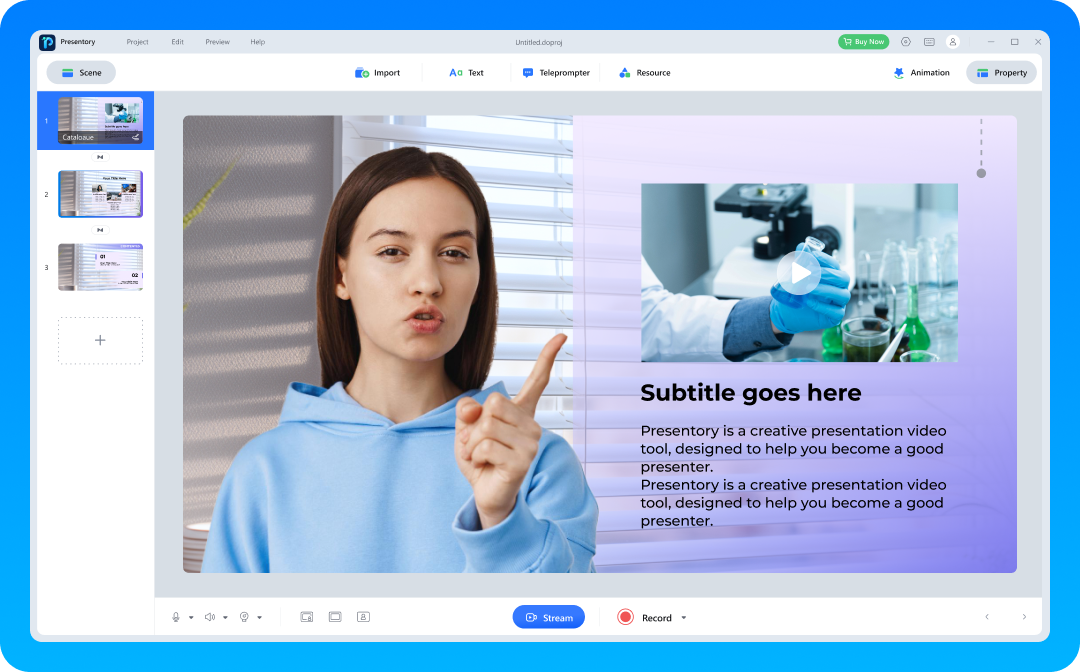
Free Download Free Download Try It Online
Key Features
Here are some of the features that make Presentory the best tool for your ESL presentation:
- Import Source Material
Import more materials for your presentations. Add images, videos, and even existing PowerPoint presentations. No need to switch between apps – everything you need is at your fingertips.
- Various Types of Font Resources
Choose from a wide selection of fonts to add a touch of creativity and professionalism to your presentations. Select the perfect font that matches your style and content effortlessly.
- Beautification Effects
It automatically recognizes portraits and adjusts your image for a polished look. Say goodbye to distracting background clutter and hello to a clean, professional appearance.
- AI Keying for Seamless Video Appearance
Removes the background image in the camera, leaving only the presenter's image. It also supports color picking, allowing you to fine-tune your video appearance effortlessly.
- Support for Popular Conferences and Live Broadcasts
Stream your ESL presentation topics with popular conferencing platforms like Zoom, Microsoft Teams, and Google Meet. Deliver your content to a global audience with ease.
- DIY Teleprompter
Adjust the window size, font color, size, and transparency to suit your preferences. Ensure a smooth and confident delivery every time.
- Noise Reduction
Eliminate distractions and ensure crystal-clear audio with Presentory's noise reduction feature. Your audience will appreciate the clarity of your message.
- Filter Effects
Add a touch of creativity to your ESL presentations with filter effects. Enhance the visual appeal of your content and keep your audience engaged.
The Bottom Line
No matter what ESL presentation topics you choose, make sure that they are something you are passionate about and can present in an engaging and informative way. With planning, you can create ESL presentations that are both educational and enjoyable for your students.
You can also add Presentory into your teaching toolkit and watch your presentations come to life with impact and engagement. With its intuitive interface and powerful features, Presentory is a good choice for ESL teachers and education influencers looking to show their expertise effectively. Try it today and watch as your students become more engaged and inspired.
You May Also Like
- 10+ Clear Business Model Canvas Templates
- Over 100 Inspiring Google Slides Themes and Ideas for Every Occasion
- How to Control Your PowerPoint by Using an Apple Watch?
Related articles
- Professional development
- Planning lessons and courses
Student presentations
In this article I would like to give you a few tips and some advice on what I've learned from helping students prepare and deliver presentations.

- Why I get students to do presentations
- Syllabus fit
- Planning a presentation lesson
- Classroom Management
Why I get students to do presentations Presentations are a great way to have students practise all language systems areas (vocabulary, grammar, discourse and phonology) and skills (speaking, reading, writing and listening). They also build confidence, and presenting is a skill that most people will need in the world of work. I find that students who are good presenters are better communicators all round, since they are able to structure and express their ideas clearly.
- Presentation skills are extremely useful both in and outside the classroom. After completing a project, a presentation is a channel for students to share with others what they have learned. It is also a chance to challenge and expand on their understanding of the topic by having others ask questions. And in the world of work, a confident presenter is able to inform and persuade colleagues effectively.
- Presentations can also form a natural part of task based learning. By focussing on a particular language point or skill, the presentation is a very practical way to revise and extend book, pair and group work. The audience can also be set a task, for example, a set of questions to answer on the presentation, which is a way of getting students to listen to each other.
Syllabus fit Normally the presentation will come towards the end of a lesson or series of lessons that focus on a particular language or skill area. It is a type of freer practice. This is because the students need to feel relatively confident about what they are doing before they stand up and do it in front of other people. If I have been teaching the past simple plus time phrases to tell a story, for example, I give my students plenty of controlled and semi controlled practice activities, such as gapfills, drills and information swaps before I ask them to present on, say, an important event in their country's history, which involves much freer use of the target grammar point.
Planning a presentation lesson Normally a presentation lesson will have an outline like this:
- Revision of key language areas
- Example presentation, which could be from a textbook or given by the teacher
- Students are given a transcript or outline of the presentation
- Students identify key stages of the example presentation – greeting, introduction, main points in order of importance, conclusion
- Focus on linking and signalling words ('Next…', 'Now I'd like you to look at…', etc.). Students underline these in the transcript/place them in the correct order
- Students are put into small groups and write down aims
- Students then write down key points which they order, as in the example
- Students decide who is going to say what and how
- Students prepare visuals (keep the time for this limited as too many visuals become distracting)
- Students practise at their tables
- Students deliver the presentations in front of the class, with the audience having an observation task to complete (see 'Assessment' below)
- The teacher takes notes for feedback later
It is important that the students plan and deliver the presentations in groups at first, unless they are extremely confident and/or fluent. This is because:
- Shy students cannot present alone
- Students can support each other before, during and after the presentation
- Getting ready for the presentation is a practice task in itself
- When you have a large class, it takes a very long time for everyone to present individually!
I find it's a good idea to spend time training students in setting clear aims. It is also important that as teachers we think clearly about why we are asking students to present.
Aims Presentations normally have one or more of the following aims:
- To inform/ raise awareness of an important issue
- To persuade people to do something
- Form part of an exam, demonstrating public speaking/presentation skills in a first or second language
I set students a task where they answer these questions:
- Why are you making the presentation?
- What do you want people to learn?
- How are you going to make it interesting?
Let's say I want to tell people about volcanoes. I want people to know about why volcanoes form and why they erupt. This would be an informative/awareness-raising presentation. So by the end, everyone should know something new about volcanoes, and they should be able to tell others about them. My plan might look like this:
- Introduction - what is a volcano? (2 minutes)
- Types of volcano (5 minutes)
- Volcanoes around the world (2 minutes)
- My favourite volcano (2 minutes)
- Conclusion (2-3 minutes)
- Questions (2 minutes)
Classroom Management I find that presentation lessons pass very quickly, due the large amount of preparation involved. With a class of 20 students, it will probably take at least 3 hours. With feedback and follow-up tasks, it can last even longer. I try to put students into groups of 3 or 4 with classes of up to 20 students, and larger groups of 5 or 6 with classes up to 40. If you have a class larger than 40, it would be a good idea to do the presentation in a hall or even outside.
Classroom management can become difficult during a presentations lesson, especially during the final presenting stage, as the presenters are partly responsible for managing the class! There are a few points I find effective here:
- Training students to stand near people who are chatting and talk 'through' the chatter, by demonstration
- Training students to stop talking if chatter continues, again by demonstration
- Asking for the audience's attention ('Can I have your attention please?')
- Setting the audience an observation task, which is also assessed by the teacher
- Limiting the amount of time spent preparing visuals
- Arranging furniture so everyone is facing the front
Most of these points are self-explanatory, but I will cover the observation task in more detail in the next section, which deals with assessment.
Assessment The teacher needs to carefully consider the assessment criteria, so that s/he can give meaningful feedback. I usually run through a checklist that covers:
- Level - I can't expect Elementary students to use a wide range of tenses or vocabulary, for example, but I'd expect Advanced students to have clear pronunciation and to use a wide range of vocabulary and grammar
- Age - Younger learners do not (normally) have the maturity or general knowledge of adults, and the teacher's expectations need to reflect this
- Needs - What kind of students are they? Business English students need to have much more sophisticated communication skills than others. Students who are preparing for an exam need to practise the skills that will be assessed in the exam.
I write a list of language related points I'm looking for. This covers:
- Range / accuracy of vocabulary
- Range / accuracy of grammar
- Presentation / discourse management- is it well structured? What linking words are used and how?
- Use of visuals- Do they help or hinder the presentation?
- Paralinguistic features
'Paralinguistics' refers to non-verbal communication. This is important in a presentation because eye contact, directing your voice to all parts of the room, using pitch and tone to keep attention and so on are all part of engaging an audience.
I find it's a good idea to let students in on the assessment process by setting them a peer observation task. The simplest way to do this is to write a checklist that relates to the aims of the lesson. A task for presentations on major historical events might have a checklist like this:
- Does the presenter greet the audience? YES/NO
- Does the presenter use the past tense? YES/NO
And so on. This normally helps me to keep all members of the audience awake. To be really sure, though, I include a question that involves personal response to the presentation such as 'What did you like about this presentation and why?'. If working with young learners, it's a good idea to tell them you will look at their answers to the observation task. Otherwise they might simply tick random answers!
Conclusion Presentations are a great way to practise a wide range of skills and to build the general confidence of your students. Due to problems with timing, I would recommend one lesson per term, building confidence bit by bit throughout the year. In a school curriculum this leaves time to get through the core syllabus and prepare for exams.
Presentations - Adult students
- Log in or register to post comments
Presentation Article
Research and insight
Browse fascinating case studies, research papers, publications and books by researchers and ELT experts from around the world.
See our publications, research and insight
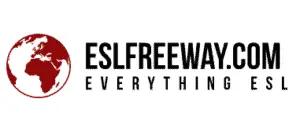
15 Speaking Projects And Activities For ESL Students
I don’t think I am sticking my neck out too much by saying that most ESL students enjoy speaking activities more than typical reading, writing and listening activities. Tending to be more dynamic, true to life and fun, a good speaking activity can really enhance an ESL student’s fluency and confidence.
Here, I am going to offer you a series of ESL speaking projects that you can adapt and use for your ESL students. Let’s go:
Infomercial Activities
This is one of my favorite speaking projects by far. Show students some typical adverts from a shopping channel; I like to show some of the funnier products just for giggles and to encourage students minds to wander, take a look at this compilation to see what I mean.
Next, I ask students usually in pairs to come up with their own completely original product to sell on an infomercial. If students struggle to come up with a completely new product you can suggest they add a new twist to arnold product, or make a new product based on a combination of two or more others.
For example, in the past I have had: microwave televisions, hair dryers that double as vacuum cleaners and laptops that double as portable stoves.
I tend to also do a language lesson based around the language of selling and persuasion so that when students make their infomercial they will send realistic and they often like to know some of the sales phrases, tactics and strategies that are used in real life.
Just for fun, you can tell students that they have a certain amount of money to spend and after they have seen all the infomercials they get to spend it. Sales can be recorded and you can see which idea/pair has made the most money and are the winner!
Presentations
Give students a presentation of a topic of your choosing, perhaps your own hobby and model the format and language that you want the students to use.
I tend to share slides with the student with the title of each slide already inserted. Students then have to fill the space with suitable information for that slide.
So, for example, if I wanted my students to present their own hobbies then I would probably have six slides titled with questions:
What is my favorite hobby? Why did I start this hobby? What have I achieved doing this hobby? Who do I do this hobby with? What will I do next in this hobby? Other interesting info about my hobby.
Students then fill the slides full of pictures that relate to the question and then they talk about these to the group and answer questions.
Some students always want to write out a script for a presentation which I let them do on the understanding that they can’t actually read it when they present. I allow them to write it out just so they can build up some confidence in what they are going to say and check the language accuracy of it.
I do usually place sentence starters and linking words on posters behind the audience so that the presenter always has some support if needs be.
Of course, this could also be done as a recorded video task. I sometimes ask students to record a voice over on top of the slides. This can then be converted into a video format for sharing later.
A few other simple presentation topic titles for ESL students that could be used are: My Best Friend, Who Am I?, My Pets, My Future Career, My Family, The Last Celebration I want to, Why I am a fan of __________ (insert name of whatever they are a fan of).
At this point you might also want to read one of my popular article about how to make your students speak English , here
Hot Seat ing
Become an expert – As it sounds. Students spent a certain amount of time researching a topic that either they choose or that is given to them. They are then to become that character and the rest of the group has to ask them questions to find out as much as they can about them in a set amount of time.
You can award points for correct questions being asked and for grammatically correct sentences in response. Personally I like to do this at the beginning of a new topic and direct students to research different famous people.
For example, if we are going to be covering the topic of Travel as in the IGCSE ESL then I have students research characters, such as: Dr Livingstone, Joe Simpson, Ernest Shackleton, Amelia Earhart, Ranulf Fiennes, and so on.
I often have students create a mini glossary for their characters as well which other students can refer to as they are quizzing the character.
This activity is best for intermediate level and above students and even then you may need to provide texts at a suitable level for students to be able to access, otherwise students end up on Wikipedia reading very difficult text.
You can have the group make notes and write summaries of each character for homework if you also wish to work on summary writing skills.
Recommended reading: 15 Research Projects For ESL Students
The Detective Game
For this activity you make up a crime that occurred in a given location, the more gruesome the better and if you can personalise it to your location and environment more the better.
Divide the group into smaller groups of three or four people and then ask them to create their alibis for the morning, afternoon, or evening in question. These people are the suspects.
One group, however, is assigned as being the investigators and they individually quiz different suspects one to one to try and find inconsistencies in their group’s stories. This forces each group to consider exactly what they were doing, where and with whom very carefully and in great detail.
After interviewing as many members of each group and making notes about inconsistencies between group members the investigators then confer with each other to decide upon which group’ alibi is the most inconsistent. This group are then sent to jail.
Whilst the investigators are discussing this, the suspects discuss which investigator was the best at questioning them and finding out the inconsistencies. The suspects will then announce who this person is, and they earn a promotion. Finally, the investigators announce the losing group which will go to prison.
This ‘game’ has got real legs and could go in so many different directions, so don’t be afraid to improvise and have fun with this one.
Drama Activities
Acting out a chapter of a book. Pretty much as it sounds. Read through a chapter of a book with students or have them read it for homework before letting groups act out the chapter, or a scene from it.
This works well even if they all act out the same scene as each group will learn from the last and the acting/performance and language should get increasingly better throughout. Alternatively arrange it so that each group acts out the following scene to the last group and so the full story is told.
Storyboard and act out the student’s own story. Rather than act out a book, you could have students plan out a story, or at least part of a story on a storyboard. This can give a greater sense of ownership, achievement and ‘buy in’ from the students.
What happened next. Read the opening of a book and as a ‘cliffhanger is reached’ pause and have students work together to act out the ending of the story or the next scene at least.
This also works well with videos from YouTube, crime videos work well as do Walt Disney cartoons – even with adult learners for some reason!
You might also be interested in reading my helpful article on how to get your students speaking fluently , here.
Mind Map ping
Vocabulary relationships. Engage students in a subject which contains lots of relationships of cause and effect. Basically, you need to pick a topic and analyse what the different factors were that affected the main decision or characters involved.
In the centre of your mind map place the decision or a character that was made and then arrange influencing factors around this.
The larger the circle each factor is in and the closer it is to the centre of the paper the stronger the influence is. Students then need to explain their mind map and the relationships to the group. Others can question and agree/ disagree with them.
Topics can range from serious issues from history through to celebrity scandals, or even plots in a movie, such as, why did celebrity couple X and Y get divorced, or why did actor x decide to y in the movie xyz. Obviously, you can let the students self select these issues for greater interest.
Backs To The Board
A timeless classic not so much a speaking project but this can be developed into a full lesson’s worth of speaking and it works for groups of all sizes. It is excellent for reviewing vocabulary at the end of a project or to see what students know at the beginning of a topic.
Simply split the group into teams of no more than five and have one member of the group come to the front and sit with their back to the board.
The other members of the group form a ‘u’ shape around the person, or, rather than being sat literally against the board groups can be sat at tables with just one student having their back to the board.
All you then need to do is to write a word on the board and the students facing the board have to get the person not facing the board to say the word without literally telling them the word. They should be encouraged to use definitions, synonyms and examples of the word where possible.
Depending on numbers, students can just shout out when they think they have the answer, or with large groups I make the students raise their hand if they think they have the answer.
The danger with debates is that to the teacher they may seem boring, or at least they do to me but have to remind myself that just because I have done the debates dozens of times, they haven’t and even the most overdone/boring sounding debates may go down like fireworks with some groups.
With that in mind here are a few of the more traditional/boring debates for your students to get their teeth into:
Which is better, country life or city life?
Should animal testing be allowed?
Should school uniforms be gotten rid of
Are cats better than dogs?
Should women be paid as much as men?
Online learning is better than classroom learning
Does money equal success in life?
I also like to see if there is something going on in the students view of the world that is worth debating. For example, in Thailand the debate over whether Korean pop music is better than Thai pop music is a popular one.
I have had colleagues dive into debates about serious political topics with higher level students which have worked really well.
However, some topics are just too hot to handle and you don’t know who you are upsetting so be careful what topics you do debate, you never know who is listening, or who is going to offense at any of your personal views that you may let slip!
Here is a good resource for more ESL debate ideas .
Book And Movie Review s
This is pretty much as it sounds. I like to set a reading task for students over a holiday break and when they return they have to submit a video review of the book or movie they watched/read.
I usually show them a good movie review for ideas and ask them to follow the same format. Something like this review of Kung Fu Panda . This goes along the lines of: background information, main characters, plot explanation, favorite moments, final recommendation.
I’ve also done this with higher level groups for documentaries but with enough support and speaking frames pre intermediate students can engage well with this activity.
Conversation Question s
Don’t underestimate the value of pure lists of conversation questions. Students are often happy to just ‘have a chat’ and use the English that they do know.
It is great for their confidence and fluency, as well as requiring zero lesson prep, which is always a nice thing. Just be sure to rotate speaking partners to avoid students getting bored with the same partners and used to different accents.
Sometimes, depending on ability and interest levels I will teach three or four idioms at the beginning of the lesson and set the task of trying to naturally drop them into conversation later on.
There are lot of good sources of conversation questions, here are a couple: eslconversationquestions.com and esldiscussions.com .
ESL Exam Preparation Material
Some students are hugely motivated by doing well in exams such as the IELTS test, and IGCSE ESL speaking tests. Exam boards for tests such as these produce a plethora of practise material that is often available for free online and ready to be use.
My students particularly enjoy the IELTS speaking part 2 task where they are required to speak about a given topic and are given three bullet points to talk about. They are given one minute to prepare their ideas before they have to speak on their own for two minutes.
If you think your students might enjoy this then here are some good sources of free IELTS style questions: IELTS IDP and ielts-exam.net , and for IGCSE ESL speaking questions check out the role play paper here.
The added bonus of these activities is that there is always a grading criteria ready to be used so you can grade students and give them real reasons why they scored a certain level and what they need to do to score higher in the future.
Here are the IELTS speaking criteria for example which clearly spells out what is expected of students at different levels.
Finger Puppet Shows
One really good way to get shy students speaking I have found to introduce sock puppets. As silly as it sounds, there is something about using a puppet that takes away the pressure on the speaker and frees them up to speak.
Whether it is the element of hilarity of speaking sock or the fact that people are generally looking at the sock rather than the person it seems to work well.
Depending on the ability level I will either give pairs of students scripts to act out with puppets. They can introduce their own props as well to make it even more funny. Alternatively, I will do this as an improv.
I will read out a situation, for example, one of you has lost their passport at the airport. Then the students have to act out this scenes as best as they can.
Switch partners and introduce more situations and watch the energy level of the room pick up!
By the end of the lesson you may well notice previously shy students speaking confidently with other students having been drawn into the magic of sock puppets! A great little speaking project.
Role Plays With Idioms
I use this lesson pattern quite regularly and it works well. I start off with student matching idioms to meanings and then to example sentences with the idioms missing.
After going through these answers and doing any teaching necessary to aid understanding I will then hand out a dialogue but with all the sentences jumbled up.
Students then have to unjumble the conversation which contains one or more of the idioms being used in a natural way. Next, they read the dialogue through taking different roles each and then doing the dialogue again without looking at the words.
Next, students are given the task of creating their own dialogues using at least one of the idioms in an appropriate way. Students write out the dialogues, rehearse them and then act them out for the group.
You can also do this with phrasal verbs but either way it works out well and the routine can be used again when you are a bit short of material or are having a hangover day!
Barrier Activities
One favourite of mine that never fails to stimulate plenty of language use is to simply create your own barrier exercise. I like to get a nice chunky newspaper article related to what we are learning and then go through each paragraph and remove key details, such as: names, dates, place names, times, location etcetera…
I create two versions of this, the first one will have words missing from odd number paragraphs and the second copy will have words missing from even number paragraphs.
This prevents it from becoming confusing and make sure to keep one master version with no details missing and if you have time highlight the missing words in red so it is easy for students to check later.
Once the missing word copies are ready you can divide the class into two halves distributing sheet A to one half and sheet B to the other half. Allow them to work in groups at this point to work out what questions they need to ask the other half of the group in order to get the missing details filled in.
If you think this will be too difficult for them you can provide the questions in a jumbled up format so they have to rearrange them to make the questions,, or even give them the questions but they have to work out the order in which to ask them to correspond to the paragraph order.
After this preparation period students can then pair up with someone from the opposite half of the group to take turns asking and answering each other’s questions.
Make sure that students do not show each other their articles and simply just sit and copy the answers, clearly this simply defeats the whale point of the exercise.
Before starting this I also pre teach any tricky vocabulary that I know is going to come up in the article just to make sure the final questions and answer session goes without too much stopping and starting to ask about vocabulary.
After students have got the answers then you can either display the answers on an overhead projector, or send students back to their original half of the group to see if they have all gotten the same answers.
Jigsaw Reading
This is another easy way to get students involved in the language and speaking. Select a relevant article related to the topic you are studying and chop it up into paragraphs. Hand out A4 paper with a simple one column table with as many boxes as there are paragraphs.
Hand out the paragraphs to the students considering which paragraphs are more difficult and should go to the higher level learners and which are slightly easier and can go to the lower ability students.
Individually, students now summarise in their own words as far as possible their paragraphs and write the summary in a box in the table. Following this students pair up with students who had a different paragraph and they then read out their summaries whilst the other students make notes of it.
Rotate partners so that everyone can get every paragraph and after the first couple of times students have read their summaries, force students to turn over their paper and explain their paragraph from memory.
After the first couple of goes they should be able to do this and by the time they have explained to everyone in the group they should be reeling off their summary very comfortably.
A Word On Differentiation …
There is a lot of fun to be had for the students in the above activities but it is important to not forget that some students will require more support than others. Just asking students to do a role play with no support may be too much for some.
Always consider using speaking frames, having sentence starters placed around the room, ‘useful language’ handouts, and always show a clear model of what it is you are expecting the students to produce.
If you can tick those boxes then your speaking lesson will go that bit more smoothly.
All the best with your ESL speaking projects!
Recent Posts
Can I Teach IELTS Without a Certificate or Qualifications?
The IELTS test is a key part of many non-native speakers' journey into entering a university in a native English-speaking country, such as the UK, or Canada. Teaching IELTS is a great way to gain...
How Bad Grammar Can Change Meaning (Real Examples)
Many people dismiss grammar as being unimportant. They claim that grammar adds little meaning to communication and is an unnecessary complication. Although grammar may change over time, it is still a...
My Life! Teaching in a Korean University
in Life in the Classroom
Presentation Project Ideas | ESL Presentation Topics, Tips, Ideas & More
Over the years teaching in a Korean university, I’ve had students do plenty of solo and group presentations. I love to do them at least once a semester because they’re great for the teacher to take a break from being at the front of the class, and designed well, students really enjoy them as well. Of course, I had to come up with some ESL presentation topics. Keep on reading to find out my presentation project ideas to try out in your own classes.

Presentation Project Ideas
Let’s get into the best ESL presentation ideas and topics.
Top 7 ESL Presentation Ideas
Here are my top presentation project ideas for ESL students with a bit of advice on how to make them work for you. Are you ready to find some ESL presentation topics and ideas for your students? Then keep on reading as we get to it!
Each student has to choose from a variety of topics such as “family” or “hobby.” They had to speak for between 1.5 and 2 minutes. I did this only once, with low-level students and it was so boring that I never did it again.
All the presentations were basically the same. “I have a mom. She is 46 years old. She has black hair and black eyes. I have a dad. He is 47 years old and he has black hair and black eyes. He is tall.” Trust me, they were some of the most tedious and excruciating hours of my entire life.
Find out : How to teach public speaking , in a far more awesome way.
And of course, I could have avoided this problem by choosing far more interesting ESL presentation topics. For example, I did a similar sort of thing with current events and the results? Much better!
#2: Presentation and Discussion Time
Each group had to give a presentation about a topic of their choosing and think of at least 5 interesting questions/surveys/activities that groups could discuss or do for about 30 minutes after their presentation.
This presentation project ideas had varying results, since some groups chose a topic that led to a lot of “yes/no” answers and discussions that lasted about 2 minutes. However, this could have been avoided by approving the topics in advance and requiring groups to submit their assignment for feedback a week or two before the actual presentation. The duds were mostly my own fault!
The key is to set up the project in a better way. The teacher needs to prepare for this activity well in advance! And of course, get students to prepare in advance as well so they can have a chance to revise their presentation if necessary.

#3: Poster Presentation
Each group had to choose a current issue (like environmental pollution, celebrity suicide, North Korea) and make a poster that had English writing and some interesting pictures. Set a(low) maximum number of words, or your posters will be terrible! Then, they had to do a presentation based on the poster where each group member spoke for 2 minutes, without a paper.
If I ever did this again, I would do something where the audience was more involved, such as peer grading. Or, I would require each group watching the presentation to think of at least 1 question to ask and they’d get a point for doing so.
Giving the students a reason to listen is key, so keep this in mind during your ESL projects.
More ideas for the classroom: Task Based Language Learning.
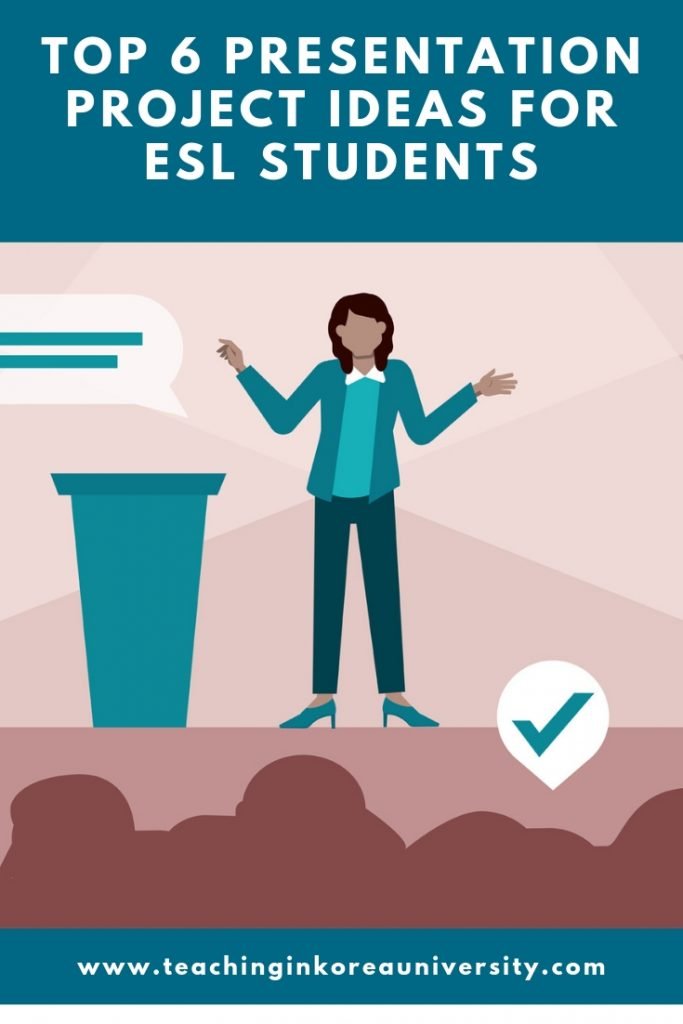
Topics for Group Presentations for ESL Students
#4: PowerPoint Presentation
This has the potential to be very interesting, or PPT death. It all depends on how you set the presentation project up. If you do go with this method, you should set a maximum number of slides and also a maximum numbers of words per slide (maybe 10?). Emphasize to students that you want to see pictures, charts, etc. and not a page of text.
Teach students how to make good PPTs and then penalize heavily for not following your recommendations. You should also coach students on how to stand to the side and still keep their body pointed towards the audience.

How to Make a Good PowerPoint Presentation (For ESL Students)
#5 Project Presentation Ideas: Making a Short Video
For homework in my conversation classes, I hated giving writing homework! It just seemed to defeat the purpose of trying to get the students to talk as much as possible.
In order to combat this, I’d often get students to make videos and then put them online on YouTube. I’d assign a topic that they had to talk about for a minute or two. Sometimes, I’d make an assignment where 2-3 of the students in the class would have to talk about something.
Or sometimes I’d require that students interview their classmates about something. It was really fun to watch these ones!
If you want to get creative, you could have your students make a short documentary or movie about a topic of their choice.
It’s simple, fun, and many students let me know that is was their favourite homework activity that semester.
#6: Impromptu Speaking Activity
If you ask your students, they’ll often tell you that they want to improve their speaking skills. By this, they often mean fluency. One way to do this is to use an activity like Just a Minute. It puts students on the spot and they’re required to talk about a certain topic for one entire minute.
It’s the perfect way to focus on speaking fluency because they can’t stop talking for the entire minute. You can make it into a conversation activity by requiring that students who are listening ask some follow-up questions.
Of course, do this in small groups for intermediate students, and only with an entire class for advanced level students. Or, consider using it if you teach ESL online .
#7: Infographic Presentation
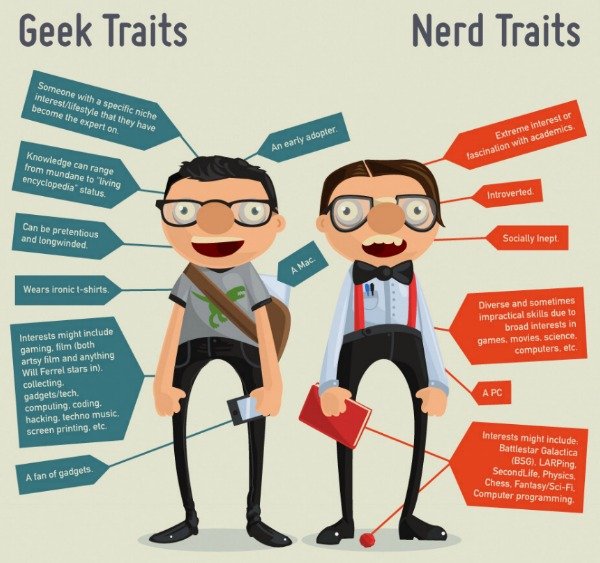
Presentations are a regular feature of ESL classes, but your students may get overwhelmed at the thought of first creating and then presenting a full-length speech. This activity works very, very well for a small class of 5 students or fewer. Private classes are even better.
However, if you have larger classes, you can do these infographic presentations in a few different ways. The first option is to put students into teams of 3-4. Another one is to have students do them for a midterm or final exam. Finally, you can have 1-2 students do a PowerPoint presentation each class as a kind of warm-up and eventually, all students will have done one by the end of the semester.
Infographics have become a common way of presenting information, and your students can create and use one to provide the “meat” of an informative oral presentation. An infographic presentation will also provide an opportunity to research a topic in English. If your students work in an office, they are likely to use PowerPoint at work, so the combination of something familiar (PPT) with something new (English presentation) should reduce stress.
Any time you can get students up and out of their seats is a win!
Choose a Topic with Several Data Points
Have your students choose a topic of interest to them that has several data points. For example, if they have a favourite team, they can find the team’s current ranking, average points per game, number of championships, and so on to populate the infographic. The students should begin the project by researching several data points and finding an image or two online to use for decoration.
To create the infographic, the students will need to reset the margins to create the long, narrow look of an infographic. This is done by choosing a blank layout and changing the slide from landscape to portrait then adjusting the margins. Start with 10”/25cm by 30”/75cm and adjust if necessary.
Your students can use images, Smart Art, and/or charts to present the data they will report. However, you may want to give your students a time limit for choosing a layout or have them make a sketch before opening PowerPoint because the number of options can become a time-waster.
Layout First, Add in Data Second
Once the layout has been chosen, your students will need to fill in the data. If they are using charts, Excel will automatically to fill them in. Don’t worry, it’s pretty self-explanatory and the end result is right there for the student to see while working. Once the images are all in place, the students should add a brief explanation of each image. All images and text boxes can be resized, and the entire slide can be resized by adjusting the margins if there is more (or less) information than expected.
When the students are satisfied with the infographic, it can be saved as a JPEG. This will probably have taken an entire lesson, so the infographic presentation will be in the next lesson. You should tailor the focus of the presentation to your student’s level and needs. Lower-level students may only need to practice speaking without a script. Higher-level students may need to practice the use of gestures or inflection.
Teaching Tips for this Presentation Activity
If your students do not use PowerPoint at work and are not familiar with it (or if you do not want to spend an entire lesson making an infographic), you may want to have the students find an existing infographic online to present. Search for “infographic” on Google Images and you’ll find many of them.
A video of the infographic presentation can be helpful for your students. When students see and hear themselves, they can more easily see the areas that need improvement.
Procedure:
1. Have your students choose a topic of interest that would have several data points to research and present.
2. Have the students make a sketch of the planned infographic.
3. Using PowerPoint, have the students make the infographic (use a blank layout, in portrait, with the margins set to 10”/25cm by 30”/75cm).
4. In the next lesson, have the students present the infographic to you. According to the student’s level, have them focus on speaking without a script, using gestures, or inflection, etc.
5. Review the infographic presentation.

- Amazon Kindle Edition
- Bolen, Jackie (Author)
- English (Publication Language)
- 278 Pages - 07/12/2020 (Publication Date)
What are Some ESL Presentation Topics to Consider?
There are a few classic ones in here, along with some fresh, new ideas for presentation topics that you’ll want to consider:
- Teach someone how to do something
- Something in the news lately
- Controversial topics (and choose a side)
- If I were president…
- Favourite book, movie, restaurant, etc.
- Vacations (past or dream for the future)
- If I had a million dollars…
- Ideal first date
- Jobs and work
- What the world will look like in 30 years from now
- Money: Are you a saver, or spender?
- What do you do when you get home from school?
Why Do ESL Presentations?
That’s a great question and we’re happy that you asked! There are a number of reasons why you might consider using presentations for an ESL project idea.
#1: Presenting is a Tangible Skill
Although I’m here to teach English, I always try to give my students some tangible skills they can take with them. For example, in a writing class , I teach students about hooks, thesis statements and topic sentences. This will be useful in any kind of writing, in any kind of language.
And, in my conversational English classes, I like to teach some presentation skills like eye contact, gestures, etc. Hopefully, they’ll use these things again in the future.
#2: They’re Ideal for Business Students
Many business people have to do presentations at work. Help them get some practise with this important skill in your classes.
#3: Helps Improve Listening Skills
When else do students listen for an hour or two, in English, that’s almost exactly at their level? During presentations. Just be sure to give some tasks to give students a reason to listen (see the section below).
#4: They’re Student Directed
I generally give some very vague guidelines as far as topics go. For example, any current events topic . Or, food/school/culture/history/hobbies. Not just one of these things, but perhaps all of them!
This way, they are free to choose whatever they’re interested in and care about. They are often more willing to learn now vocabulary than if I were to just assign a random topic.
Of course, for best results, do be strict about time limits, PowerPoint slides, etc.
#5: It’s a Break from the Usual
Teacher talks, students listen. Sounds familiar? Mix it up in your classes, and have the students do all the talking.
How Can I Increase Audience Engagement?
It’s an excellent question! How can you keep the rest of your students engaged and learning English while other students are doing presentations? There are a few related strategies I like to use to do this. Remember, presentations can be a source of some serious listening and vocabulary practice, so do everything you can to take advantage of this!
Idea #1: Worksheets
Sometimes I require the group or person doing the presentation to come up with a few quick comprehension questions based on their presentation. Multiple-choice, true/false or short answer works well for this.
Then, before their presentation, students have to hand out the worksheet to their classmates. This gives people a reason to listen, and even if there are no grades attached to this, most students will do it.
Idea #2: Follow-Up Questions
Sometimes I put the audience in groups of 3-4. Then immediately after the presentation, I give them a couple of minutes to come up with 3-4 interesting follow-up questions based on the presentation. I choose a few groups to ask one of their questions to the presenter. Or, everyone has a chance to ask a question in the smaller classes.
Idea #3: Peer Grading
Peer grading is an interesting thing I’ve tried in my more mature classes. I’ve almost never seen students watch so closely. Students find this kind of thing surprisingly fun!
I generally let students assign 50% of the grade to their peers, and then I reserve 50% for my own grade. It works best if you give students clearly defined categories that they have to evaluate.
The only downside is that it can take quite a bit of time to compile all the numbers from this in a bigger class.
Idea #4: Taking Notes
Sometimes I’ll require that students take some notes from the presentation. Generally, 4-5 bullet points work well per presentation. It’s great listening and note-taking practise for our students.
Or, get students to write down 3-4 phrases that they hear from each presentation. It’s simple but effective at getting students to work with the language.
Quick tips:
The key to this working well is to coach students about how to take notes. They don’t have to write full sentences, but just the key words or phrases.
At the end of class, I have students show me their notes for some participation points. This activity does not work that well if no points or grades are attached to their work.
Idea #5: Choose ESL Presentation Ideas Carefully
The final thing to do to increase audience engagement is to choose the topics carefully. If the students find them interesting, they’ll listen. It’s really that simple and the best way to ensure success is to come up with some great ESL presentation topics.

- 148 Pages - 03/09/2016 (Publication Date)
How do I Make my Presentation Stand Out? Top 10 Tips
There are a few ways that you can really make your presentation stand out from the crowd. Here are some of the best ways:
- Use an icebreaker
- Tell stories
- Consider using videos or pictures
- Embrace the non-linear style
- Interact with your audience (ask them a question)
- Don’t forget about eye contact
- Move around
- Practice, practice, practice!
Don’t Forget This Book for Teaching Public Speaking!
If you want to teach presentations to ESL students, you’ll need this most awesome of books. It’s full of great resources for teaching public speaking.
Speaking of Speech: Basic Presentation Skills for Beginners
Trust me, it’ll make your life way easier and happier.
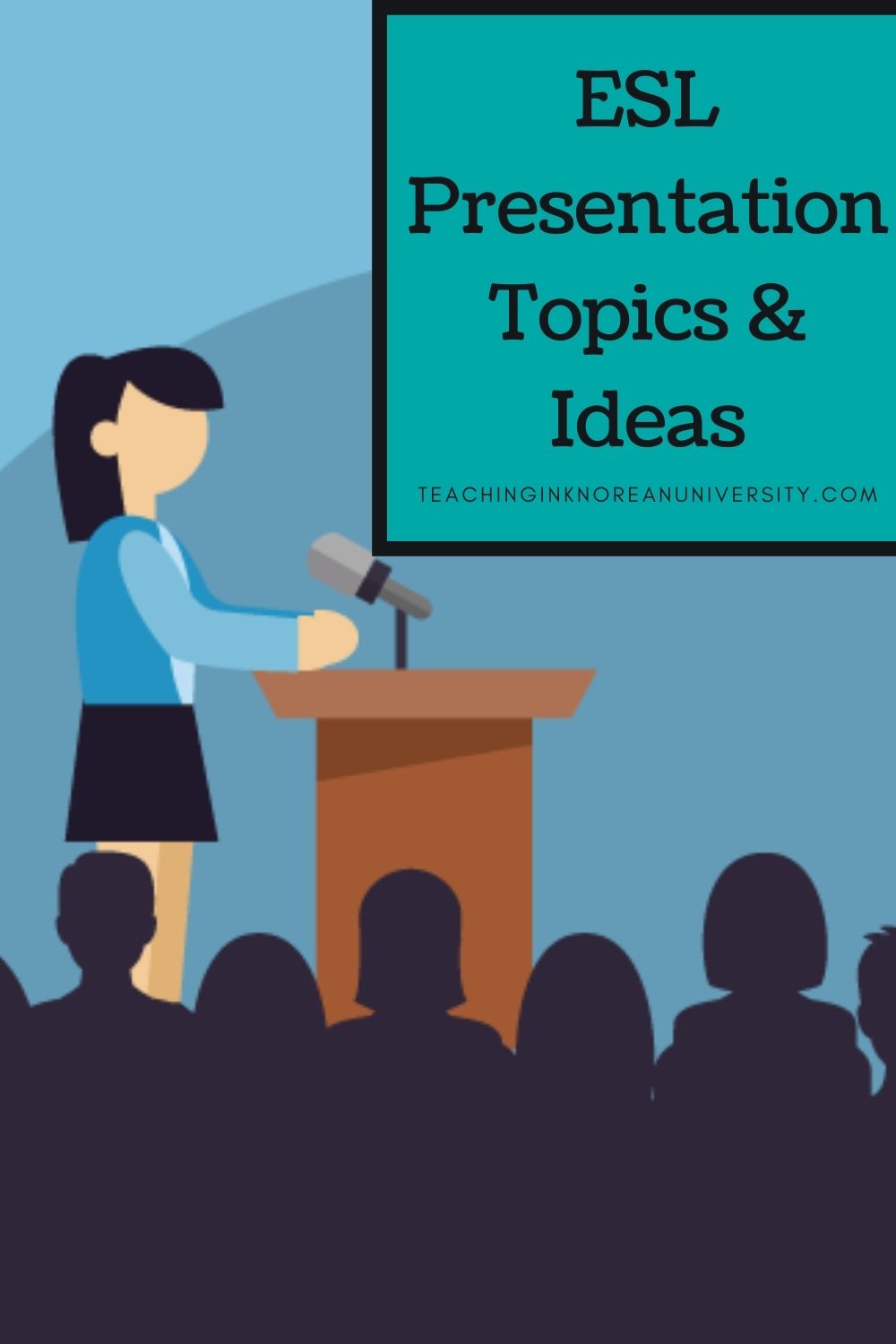
ESL presentation ideas
ESL Presentation Ideas FAQs
There are a number of common questions that people have about English learners giving presentations. Here are the answers to some of the most popular ones.
How do I make a good ESL presentation?
There are a few simple steps you can follow for making a good ESL presentation.
- Do lots of preparation and allow time for this.
- Structure your presentation (beginning, middle, end).
- Make notes on keywords but don’t write out full sentences.
- Rehearse lots.
- Use a PowerPoint slide or two but don’t include lots of text on it.
- Allow time for questions from the audience.
- Make eye contact and use hand gestures.
How do you write a speech for ESL?
To write a speech for ESL, check out these simple tips:
- Consider using short sentences with contractions.
- Use simple words like you’d use when having a conversation with someone.
- Read your speech out loud as you are writing it.
- Get someone to listen to you as you say it and point out any awkward or boring parts.
What is a good presentation topic?
A good presentation topic is one where you know a lot about the subject, either through personal experience or by doing lots of research. It’s also one that the audience has a general interest in.
How do you teach presentation skills to ESL students?
You can teach presentation skills to ESL students by using some of the following activities:
- Recite a famous speech.
- Give a presentation in a small group of 3-4 students.
- Do a solo presentation and put it on YouTube.
- Do quick presentations on a random topic with only a few minutes to prepare.
- Act out a play with the class.
- Work on things like eye contact and hand gestures.
- Teach students how to structure a presentation well.
What are your Presentation Project Ideas?
Do you have any ideas for presentations for English language learners? Do you love, or hate presentation day in your classes? Leave a comment below and let us know! We’d love to hear from you.
And don’t forget to share this article on Facebook, Twitter, or Pinterest. It’ll help other busy teachers, like yourself find this useful resource.
Last update on 2022-06-17 / Affiliate links / Images from Amazon Product Advertising API
About Jackie
Jackie Bolen has been teaching English for more than 15 years to students in South Korea and Canada. She's taught all ages, levels and kinds of TEFL classes. She holds an MA degree, along with the Celta and Delta English teaching certifications.
Jackie is the author of more than 30 books for English teachers and English learners, including Advanced English Conversation Dialogues and 39 No-Prep/Low-Prep ESL Speaking Activities for Teenagers and Adults . She loves to share her ESL games, activities, teaching tips, and more with other teachers throughout the world.
You can find her on social media at: Facebook Pinterest
About and Contact
Jackie Bolen has been talking ESL South Korea since 2014. The goal is to bring you the best tips, ideas, and news for everything teaching English in Korea, including university jobs.
Contact Jackie Bolen and My Life! Teaching in a Korean University here.
Email: [email protected]
Address: 2436 Kelly Ave, Port Coquitlam, Canada
Find the Privacy Policy here .
Best Seller
As an Amazon Associate, I earn from qualifying purchases.
Advertise on My Life! Teaching in Korean University
Recent Articles
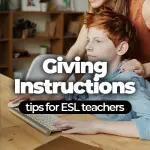
The Best Tips for Giving Instructions to ESL Students

71 Ways to Practice English Writing: Tips for ESL/EFL Learners

Teaching English in Korean Universities: The Ultimate Guide

Fun Debate Topics: Check out these Funny Debate Questions
ESL Presentation Rubric
- Resources for Teachers
- Pronunciation & Conversation
- Writing Skills
- Reading Comprehension
- Business English
- TESOL Diploma, Trinity College London
- M.A., Music Performance, Cologne University of Music
- B.A., Vocal Performance, Eastman School of Music
In-class presentations are a great way to encourage a number of English communicative skills in a realistic task that provides students not only help with their English skills but prepares them in a broader way for future education and work situations. Grading these presentations can be tricky, as there are many elements such as key presentation phrases beyond simple grammar and structure, pronunciation and so on that make a good presentation. This ESL presentation rubric can help you provide valuable feedback to your students and has been created with English learners in mind. Skills included in this rubric include stress and intonation , appropriate linking language, body language , fluency, as well as standard grammar structures.
- ESL Essay Writing Rubric
- How to Teach Essay Writing
- How to Teach Pronunciation
- Top Vocabulary Building Books
- Dear Abby Lesson Plan
- Writing English Drama Scripts in ESL Class
- Learn How to Use YouTube in the ESL Classroom
- Standard Lesson Plan Format for ESL Teachers
- Top Lesson Plans for ESL and EFL
- How to Successfully Teach English One-to-One
- CALL Use in the ESL/EFL Classroom
- Beginning Level Curriculum for ESL Classes
- Process Writing
- Dialogue Activities for ESL Students
- Understand Your Class With This Fun Survey for ESL/EFL Learners
- 5 Top English Learner Dictionaries
You are using an outdated browser. Please upgrade your browser or activate Google Chrome Frame to improve your experience.
7 Activities for Public Speaking That Will Boost ESL Students’ Confidence
Public speaking can be a scary thing.
Also known as glossophobia , the fear of public speaking is a major source of anxiety for roughly 75% of people worldwide .
However, public speaking is an essential skill everyone needs to have , including language learners.
The good news is that it gets easier with practice, which is why you should try out some of the below activities for public speaking that will help improve your or your students’ skills.
1. Watch TED Talks and observe body language
2. practice mimicking body language, 3. recite famous speeches, 4. give presentations in small groups, 5. prepare solo presentations using powerpoint, 6. do improvised presentations on random topics, 7. do some drama activities.
Download: This blog post is available as a convenient and portable PDF that you can take anywhere. Click here to get a copy. (Download)
Playing videos from TED Talks is a fantastic way for you to see people giving professional-quality presentations in English. The TED Talks website is filled with hundreds of different speakers, with topics ranging from the fascinating world of technology to the meaning of life.
Here’s a list of excellent TED talks presentations for ESL students , along with guidelines on how to use them in the classroom.
Think about things you like and don’t like about the presentation as you watch the video. Once the presentation has ended, write down the positive and negative aspects you observed. This will get you thinking about what kind of techniques you can implement in your own speeches, as well as which mistakes to avoid.
To give yourself or your students a well-rounded learning experience, you could add FluentU to your toolbox. FluentU is a language learning program that allows you to watch a library of authentic English videos with interactive dual-language subtitles. This can be a great way to break down what each video contains.
Good public speaking skills aren’t just about using clever words and speaking clearly— body language is equally as important . Incidentally, there’s a TED Talk you can watch covering the power of body language.
Start by brainstorming different types of body language, like gestures, postures and facial expressions. You can select actions like smiling, frowning, crossing your arms and more. After introducing body language, try matching your examples to various emotions and messages.
The results of this can be surprising because some meanings of expressions and gestures vary depending on the culture. Gestures that may seem polite could be offensive in other countries. For example, the “thumbs up” sign may seem universal for good job , but in Australia, Greece and the Middle East, it could be construed as an offensive insult.
Once you’ve elicited examples of positive and negative body language, practice how to use good body language in your presentations .
Making a speech is difficult enough, but writing a good one can feel like an impossible challenge to a beginner ESL learner.
Take some of the pressure off by reciting famous speeches. That way, you can focus on speaking skills without diving into writing or grammar.
Speeches can be taken from historical figures, social media and even movies. For beginners, you could work with a selection of famous short poems . For advanced students, try a longer speech, such as John F. Kennedy’s “Moon Speech.”
Standing alone in front of the class can be a nerve-wracking experience, even for the most gifted of learners.
If you aren’t ready for solo presentations, work in small groups so all of the attention isn’t focused on one individual learner. This can be done in just about any context, from proposing a business idea to describing how to cook your favorite food.
If you’re teaching this exercise, monitoring your students’ activity can be difficult with several groups working at the same time, so have your students assess each other.
Give every student a scoring sheet with criteria covering things like voice projection, timing, entertainment and ease of understanding. As your students listen, each group can score their partners based on this criteria. Then, you can use their scoring sheets to give feedback at the end of the class.
When you feel ready to come up with your own material, try preparing your own presentations with the help of PowerPoint.
PowerPoint slides are a great visual aid, as well as a way to make the presentation easier for nervous students.
Make sure the topic is a suitable difficulty level, and ideally, something you’re interested in. Just make sure to give enough time to write a presentation script and create the PowerPoint slides to go along with it.
I recommend planning the project in advance so there’s time to work on the presentations. Students who don’t have PowerPoint on their computer can use Google Slides as an alternative . It’s free and just as effective.
Once you or your students have built up some confidence in speaking, you can start trying some real challenges , like on-the-spot presentations.
Do this by writing out a list of different topics and putting them in a hat, bag or any other object you or the students have to stick your hand into. These topics could be anything from my dream job to the importance of a healthy diet.
Randomly select one topic, and without any preparation time, talk to the class or another audience for as long as they can about their chosen topic.
Public speaking doesn’t have to be about presentations. You can change things up a bit by trying some drama activities as well.
These could include role plays and reenactments of famous movie scenes. While acting, students still use skills like good body language, voice projection, intonation and even improvisation to make their dialogue sound natural and convincing.
While lectures and note-taking can be beneficial, nothing compares to the hands-on experience you can get from practicing public speaking.
That’s why you should implement some of the above activities for public speaking into your lessons or personal learning plans to improve confidence and overall speaking quality.
Enter your e-mail address to get your free PDF!
We hate SPAM and promise to keep your email address safe


SpeakUp resources
Starting a presentation in english: methods and examples.
- By Jake Pool
If you’re going to make it in the professional world, most likely you’ll have to give a presentation in English at some point. No reason to get nervous!
Most of the work involved lies in the introduction. You may or may not need an English presentation PPT file, your topic, audience, or time limit may vary, but a strong opening is a must no matter what! Everything that follows can build from the opening outline you present to your audience.
Let’s look at some guidelines for starting a presentation in English. If you can master this part, you’ll never have to worry about the rest!
Opening in a Presentation in English
While it’s important to have your entire presentation organized and outlined, planning and organization are especially important in the introduction. This is what will guide you through a clear and concise beginning. Let’s look at how to start a presentation with well-organized thoughts .
Introduction Outline
- Introduce yourself and welcome everyone.
- State the purpose of your presentation
- Give a short overview of the presentation
As we say, it’s as easy as 1-2-3. (No need for a more detailed English presentation script!) Let’s examine the first step.
1. Introduce Yourself & Welcome Everyone
The self-introduction is your opportunity to make a good first impression. Be sure to open with a warm welcome and use language that is familiar and natural. Based on your audience, there are a few different expressions you can use to start your presentation.
If you’re presenting to coworkers who may already know you:
- Hello, [name] here. I would like to thank you all for your time. As you may know, I [describe what you do/your job title] I look forward to discussing [topic] today.
- Good morning/afternoon/evening everyone. Thank you for being here. For those who don’t know me, my name is [name], and for those who know me, hello again.
If you’re presenting to people you’ve never met:
- Hello everyone, it’s nice to meet you all. My name is [name] and I am the [job/title].
- Hello. Welcome to [event]. My name is [name] and I am the [job/title]. I’m glad you’re all here.
There are certainly more ways to make an introduction. However, it’s generally best to follow this format:
- Start with a polite welcome and state your name.
- Follow with your job title and/or the reason you’re qualified to speak on the topic being discussed.
2. State the Purpose of Your Presentation
Now that your audience knows who you are and your qualifications, you can state the purpose of your presentation. This is where you clarify to your audience what you’ll be talking about.
So, ask yourself, “ What do I want my audience to get from this presentation? ”
- Do you want your audience to be informed?
- Do you need something from your audience?
- Do you want them to purchase a product?
- Do you want them to do something for the community or your company?
With your goal in mind, you can create the next couple of lines of your presentation. Below are some examples of how to start.
- Let me share with you…
- I’d like to introduce you to [product or service]
- Today I want to discuss…
- I want to breakdown for you [topic]
- Let’s discuss…
- Today I will present the results of my research on [topic]
- By the end of this presentation, you’ll understand [topic]
- My goal is to explain…
- As you know, we’ll be talking about…
When talking about the purpose of your presentation, stick to your goals. You purpose statement should be only one to three sentences. That way, you can give your audience a clear sense of purpose that sets them up for the rest of the presentation.
3. A Short Overview of the Presentation
The final step in starting your presentation is to give a short outline of what you’ll be presenting. People like a map of what to expect from a presentation.
It helps them organize their thoughts and gives a sense of order. Also, it lets the audience know why they’re listening to you. This is what you’ll use to grab their attention, and help them stay focused throughout the presentation.
Here are some examples of how you can outline your presentation:
- Today, I’m going to cover… Then we’ll talk about… Lastly, I’ll close on…
- We’re going to be covering some key information you need to know, including…
- My aim with this presentation is to get you to… To do that we’ll be talking about…
- I’ve divided my presentation into [number] sections… [List the sections]
- Over the next [length of your presentation] I’m going to discuss…
That’s it! It’s as simple as 1-2-3. If you have a fear of public speaking or are not confident about presenting to a group of people, follow these three steps. It’s a simple structure that can get you off to a good start. With that in mind, there are other ways to bring your introduction to the next level too! Read on for bonus tips on how to really engage your audience, beyond the basics.
For a Strong Presentation in English, Engage your Audience
Presentations aren’t everyone’s strongest ability, and that’s OK. If you’re newer to presenting in English, the steps above are the basics to getting started. Once you’re more comfortable with presenting, though, you can go a step further with some extra tricks that can really wow your audience.
Mastering the skill of engaging an audience will take experience. Fortunately, there are many famous speakers out there you can model for capturing attention. Also, there are some common techniques that English-speakers use to gain an audience’s attention.
*How and when you use these techniques in your introduction is at your discretion, as long as you cover the 3 steps of the introduction outline that we discussed earlier.*
Do or say something shocking.
The purpose of shocking your audience is to immediately engage them. You can make a loud noise and somehow relate the noise to your presentation. Or, you can say, “ Did you know that… ” and follow with a shocking story or statistic. Either way, the objective is to create surprise to draw their attention.
Tell a story
Telling a story related to your presentation is a great way to get the audience listening to you.
You can start by saying, “ On my way to [location] the other day… ” or “ On my way here, I was reminded of… ” and then follow with a story. A good story can make your presentation memorable.
Ask your audience to take part
Sometimes a good introduction that captures attention will involve asking for help from the audience. You can ask the audience to play a quick game or solve a puzzle that’s related to your presentation. Also, you could engage the audience with a group exercise. This is a great way to get people involved in your presentation.
There are many more ways to engage the audience, so get creative and see what you can think up! Here are some resources that will help you get started.
Also, if you want to get better at public speaking (and help your English speaking too!), a great organization to know about is the Toastmasters . The organization is dedicated to helping you be a better speaker, and there are many local groups in America. They offer free lessons and events to help you master your English speaking, and also offer additional help to paying members.
The Takeaway
A presentation in English? No problem, as long as your introduction sets you up for success . Admittedly, this can be easier said than done. Native speakers and non-native speakers alike sometimes struggle with getting a good start on their English presentation. But the advice above can help you get the confidence you need to lay a good foundation for your next speech !
Free practice (Facebook group)
Phone: +1 (510) 560-7571
Terms of Use
Privacy Policy
Company Home
- Skip to Nav
- Skip to Main
- Skip to Footer

How to Use Oral Presentations to Help English Language Learners Succeed
Please try again

Excerpted from “ The ELL Teacher’s Toolbox: Hundreds of Practical Ideas to Support Your Students ,” by Larry Ferlazzo and Katie Hull Sypnieski, with permission from the authors.
Having the confidence to speak in front of others is challenging for most people. For English Language Learners, this anxiety can be heightened because they are also speaking in a new language. We’ve found several benefits to incorporating opportunities for students to present to their peers in a positive and safe classroom environment. It helps them focus on pronunciation and clarity and also boosts their confidence. This type of practice is useful since students will surely have to make presentations in other classes, in college, and/or in their future jobs. However, what may be even more valuable is giving students the chance to take these risks in a collaborative, supportive environment.
Presentations also offer students the opportunity to become the teacher—something we welcome and they enjoy! They can further provide valuable listening practice for the rest of the class, especially when students are given a task to focus their listening.
Research confirms that in order for ELLs to acquire English they must engage in oral language practice and be given the opportunity to use language in meaningful ways for social and academic purposes (Williams & Roberts, 2011). Teaching students to design effective oral presentations has also been found to support thinking development as “the quality of presentation actually improves the quality of thought, and vice versa” (Živković, 2014, p. 474). Additionally, t he Common Core Speaking and Listening Standards specifically focus on oral presentations. These standards call for students to make effective and well-organized presentations and to use technology to enhance understanding of them.
GUIDELINES AND APPLICATION
Oral presentations can take many different forms in the ELL classroom—ranging from students briefly presenting their learning in small groups to creating a multi-slide presentation for the whole class. In this section, we give some general guidelines for oral presentations with ELLs. We then share ideas for helping students develop their presentation skills and describe specific ways we scaffold both short and long oral presentations.
We keep the following guidelines in mind when incorporating oral presentations into ELL instruction:
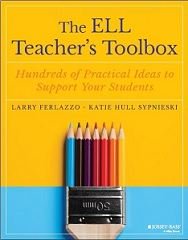
Length —We have students develop and deliver short presentations (usually 2-4 minutes) on a regular basis so they can practice their presentation skills with smaller, less overwhelming tasks. These presentations are often to another student or a small group. Once or twice a semester, students do a longer presentation (usually 5-8 minutes), many times with a partner or in a small group.
Novelty —Mixing up how students present (in small groups, in pairs, individually) and what they use to present (a poster, a paper placed under the document camera, props, a slide presentation, etc.) can increase engagement for students and the teacher!
Whole Class Processing -- We want to avoid students “tuning out” during oral presentations. Not only can it be frustrating for the speakers, but students also miss out on valuable listening practice. During oral presentations, and in any activity, we want to maximize the probability that all students are thinking and learning all the time. Jim Peterson and Ted Appel, administrators with whom we’ve worked closely, call this “whole class processing” (Ferlazzo, 2011, August 16) and it is also known as active participation. All students can be encouraged to actively participate in oral presentations by being given a listening task-- taking notes on a graphic organizer, providing written feedback to the speaker, using a checklist to evaluate presenters, etc.
Language Support —It is critical to provide ELLs, especially at the lower levels of English proficiency, with language support for oral presentations. In other words, thinking about what vocabulary, language features and organizational structures they may need, and then providing students with scaffolding, like speaking frames and graphic organizers. Oral presentations can also provide an opportunity for students to practice their summarizing skills. When students are presenting information on a topic they have researched, we remind them to summarize using their own words and to give credit when using someone else’s words.
Technology Support —It can’t be assumed that students have experience using technology tools in presentations. We find it most helpful using simple tools that are easy for students to learn (like Powerpoint without all the “bells and whistles” or Google Slides). We also emphasize to students that digital media should be used to help the audience understand what they are saying and not just to make a presentation flashy or pretty. We also share with our students what is known as “The Picture Superiority Effect”-- a body of research showing that people are better able to learn and recall information presented as pictures as opposed to just being presented with words (Kagan, 2013).
Groups -- Giving ELLs the opportunity to work and present in small groups is helpful in several ways. Presenting as a group (as opposed to by yourself) can help students feel less anxious. It also offers language-building opportunities as students communicate to develop and practice their presentations. Creating new knowledge as a group promotes collaboration and language acquisition--an ideal equation for a successful ELL classroom!
Teacher feedback/student evaluation --The focus of oral presentations with ELL students should be on the practice and skills they are gaining, not on the grade or “score” they are earning. Teachers can give out a simple rubric before students create their presentations. Then students can keep these expectations in mind as they develop and practice their presentations. The teacher, or classmates, can then use the rubric to offer feedback to the speaker. We also often ask students to reflect on their own presentation and complete the rubric as a form of self-assessment. Figure 30.1 – “Presentation Peer Evaluation Rubric” , developed by talented student teacher Kevin Inlay (who is now a teacher in his own classroom), is a simple rubric we used to improve group presentations in our ELL World History class.
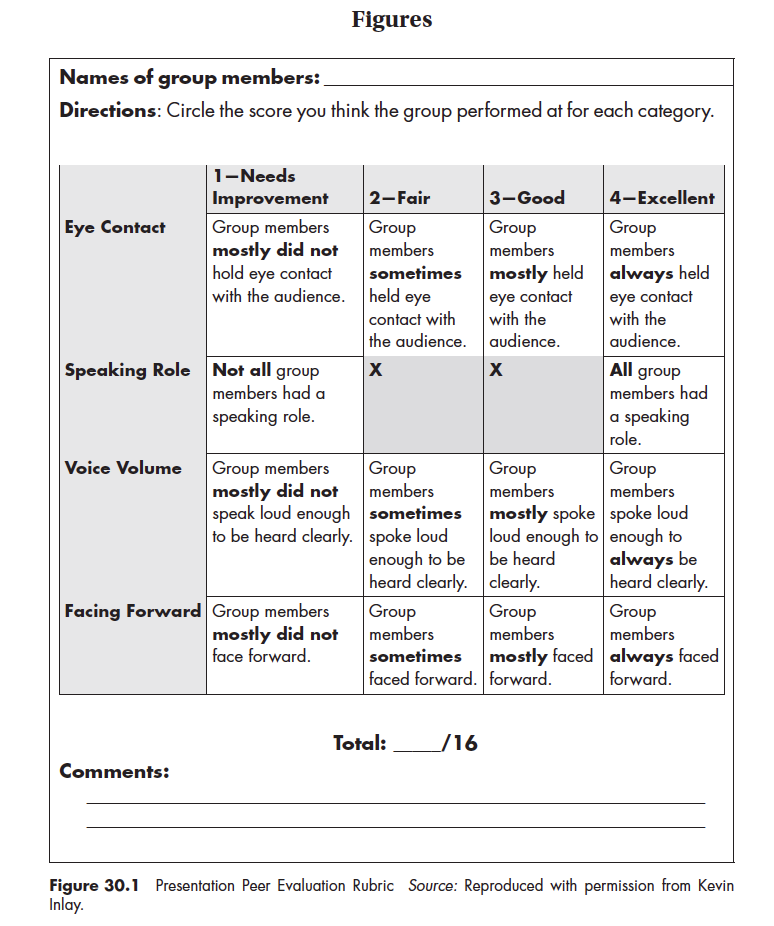
Teaching Presentation Skills
We use the following two lesson ideas to explicitly teach how to develop effective presentation skills:
LESSON ONE: Speaking and Listening Do’s and Don’ts
We help our students understand and practice general presentation skills through an activity we call Speaking and Listening “Do’s and Don’ts.” We usually spread this lesson out among two class periods.
We first ask students to create a simple T-chart by folding a piece of paper in half and labeling one side “Do” and the other side “Don’t.” We then post Figure 30.2 “Speaking Do’s and Don’ts” on the document camera and display the first statement (the rest we cover with a blank sheet of paper).
We read the first statement, “Make eye contact with the audience,” and ask students if this is something they want to do when they are giving a presentation or if it is something they don’t want to do. Students write the statement where they think it belongs--under the “Do” column or “Don’t” Column. Students then share their answer with a partner and discuss why they put it in that column. After calling on a few pairs to share with the class, we move down the list repeating the same process of categorizing each statement as a “Do” or a “Don’t.” Students write it on their chart and discuss why it should be placed there.
After categorizing the statements for speaking, we give students Figure 30.3 “Listening Do’s and Don’ts .” We tell students to work in pairs to categorize the statements as something they do or something they don’t want to do when listening to a student presentation. This time, we ask students to make a quick poster with the headings “Do’s” and “Don’ts” for Listening. Under each heading students must list the corresponding statements--the teacher can circulate to check for accuracy. Students are asked to talk about why each statement belongs in each category and should be prepared to share their reasoning with the class. Students must also choose one “do” statement and one “don’t” statement to illustrate on their poster. Students can present their posters in small groups or with the whole class. This serves as a great opportunity to apply the speaking and listening “do’s” they just reviewed and heightens their awareness of the “don’ts!”
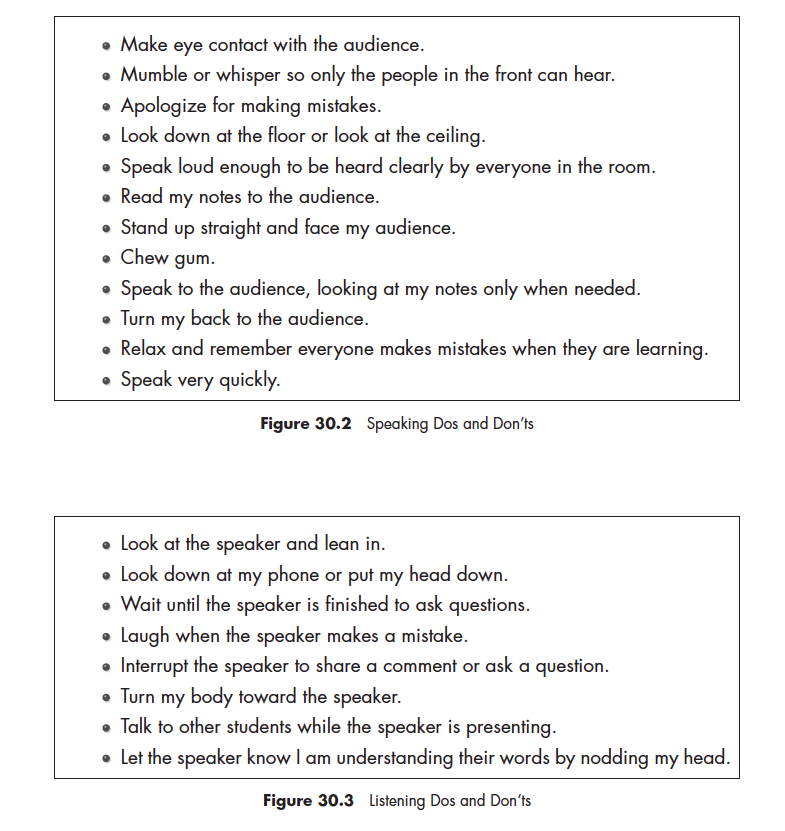
A fun twist, that also serves as a good review on a subsequent day, is to ask groups of students to pick two or three “do’s” and “don’ts” from both Speaking and Listening to act out in front of the class.
LESSON TWO Slide Presentations Concept Attainment
We periodically ask students to make slide presentations using PowerPoint or Google Slides to give them practice with developing visual aids (see the Home Culture activity later in this section). We show students how to make better slides, along with giving students the language support they may need in the form of an outline or sentence starters. An easy and effective way to do this is through Concept Attainment.
Concept Attainment involves the teacher identifying both "good" and "bad" examples of the intended learning objective. In this case, we use a PowerPoint containing three “good” slides and three “bad” ones (see them at The Best Resources For Teaching Students The Difference Between A Good and a Bad Slide ).
We start by showing students the first example of a “good” or “yes” slide (containing very little text and two images) and saying, “This is a yes.” However, we don’t explain why it is a “yes.” Then we show a “bad” or “no” example of a slide (containing multiple images randomly placed with a very “busy background”), saying, “This is a no” without explaining why. Students are then asked to think about them, and share with a partner why they think one is a "yes" and one is a "no."
At this point, we make a quick chart on a large sheet of paper (students can make individual charts on a piece of paper) and ask students to list the good and bad qualities they have observed so far. For example, under the “Good/Yes” column it might say “Has less words and the background is simple” and under the “Bad/No” column “Has too many pictures and the background is distracting.”
We then show the second “yes” example (containing one image with a short amount of text in a clear font) and the “no” example (containing way too much text and using a less clear font style). Students repeat the “think-pair-share” process and then the class again discusses what students are noticing about the “yes” and “no” examples. Then they add these observations to their chart.
Students repeat the whole process a final time with the third examples. The third “yes” example slide contains one image, minimal text and one bullet point. The third “no” example, on the other hand, contains multiple bullet points.
To reinforce this lesson at a later date, the teacher could show students more examples, or students could look for more “yes” and “no” examples online. They could continue to add more qualities of good and bad slides to their chart. See the Technology Connections section for links to good and bad PowerPoint examples, including the PowerPoint we use for this Concept Attainment lesson.
You can learn more about other presentations that support public speaking, such as home culture presentations, speed dating, talking points, top 5 and PechaKucha Book talks in our book, “ The ELL Teacher’s Toolbox: Hundreds of Practical Ideas to Support Your Students .”

Larry Ferlazzo has taught English Language Learners, mainstream and International Baccalaureate students at Luther Burbank High School in Sacramento for 15 years. He has authored eight books on education, hosts a popular blog for educators, and writes a weekly teacher advice column for Education Week Teacher . He was a community organizer for 19 years prior to becoming a high school teacher.

Katie Hull Sypnieski has worked with English Language Learners at the secondary level for over 20 years. She currently teaches middle school ELA and ELD at Rosa Parks K-8 School in Sacramento, California. She is a teaching consultant with the Area 3 Writing Project at the University of California, Davis and has leads professional development for teachers of ELLs. She is co-author (with Larry Ferlazzo) of The ESL/ELL Teacher’s Survival Guide and Navigating the Common Core with English Language Learners .
Topic: Presentation Skills

As you can see in the slide (giving presentations)
Step into the world of presentations with this handy lesson! Students explore vocabulary for structuring presentations, read the text of a presentation and watch a video on how to communicate ideas clearly.

Presentation: putting skills into action
With this lesson plan, students practise giving a presentation in English by doing a lot of different speaking activities. The lesson is the third of the three-part series of lessons about delivering presentations.
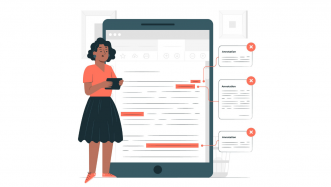
Moving through your presentation
With this lesson plan, students learn plenty of useful phrases for presentations in English. They also prepare presentation excerpts, and learn how to start a presentation. The lesson is the second of the three-part series of lessons about delivering presentations.

How to nail that presentation
In this lesson about business presentations in English, students discuss presentation structures in depth, watch a video with tips on giving presentations, and learn useful words and phrases related to the topic. The lesson is the first of the three-part series of lessons about delivering presentations.

The city of the future is here
With this lesson plan based on a video about Toyota’s city of the future students learn some useful language for presentations and then practise their presentation skills.

The chair that conquered the world
This lesson plan about the chair that conquered the world includes a variety of tasks for students to learn new vocabulary related to describing furniture design and practise their presentation skills.

How do you like your milk?
In this lesson, students will learn advanced cooking verbs, discuss different types of milk and do an English class project.

Apple’s legendary keynotes
The objective of this lesson plan is to teach students some adjectives for describing products and show them a video analysing Apple’s legendary keynotes.
Subscribe to get premium content
Subscribe to get access to professional, ready-to-use lesson plans in both digital and printable formats . Discover a variety of lesson types: Standard Lessons, Speaking Classes, Critical Reading Club worksheets and Flipped Classroom lesson plans.
Username or Email Address
Remember Me
Search form
- Speaking exams
- Typical speaking tasks
Oral presentation
Giving an oral presentation as part of a speaking exam can be quite scary, but we're here to help you. Watch two students giving presentations and then read the tips carefully. Which tips do they follow? Which ones don’t they follow?
Instructions
Watch the video of two students doing an oral presentation as part of a speaking exam. Then read the tips below.
Melissa: Hi, everyone! Today I would like to talk about how to become the most popular teen in school.
Firstly, I think getting good academic results is the first factor to make you become popular since, having a good academic result, your teacher will award you in front of your schoolmates. Then, your schoolmates will know who you are and maybe they would like to get to know you because they want to learn something good from you.
Secondly, I think participating in school clubs and student unions can help to make you become popular, since after participating in these school clubs or student union, people will know who you are and it can help you to make friends all around the school, no matter senior forms or junior forms.
In conclusion, I think to become the most popular teen in school we need to have good academic results and also participate in school clubs and student union. Thank you!
Kelvin: Good evening, everyone! So, today I want to talk about whether the sale of cigarettes should be made illegal.
As we all know, cigarettes are not good for our health, not only oneself but also other people around. Moreover, many people die of lung cancer every year because of smoking cigarettes.
But, should the government make it illegal? I don’t think so, because Hong Kong is a place where people can enjoy lots of freedom and if the government banned the sale of cigarettes, many people would disagree with this and stand up to fight for their freedom.
Moreover, Hong Kong is a free market. If there's such a huge government intervention, I think it’s not good for Hong Kong’s economy.
So, if the government wants people to stop smoking cigarettes, what should it do? I think the government can use other administrative ways to do so, for example education and increasing the tax on cigarettes. Also, the government can ban the smokers smoking in public areas. So, this is the end of my presentation. Thank you.
It’s not easy to give a good oral presentation but these tips will help you. Here are our top tips for oral presentations.
- Use the planning time to prepare what you’re going to say.
- If you are allowed to have a note card, write short notes in point form.
- Use more formal language.
- Use short, simple sentences to express your ideas clearly.
- Pause from time to time and don’t speak too quickly. This allows the listener to understand your ideas. Include a short pause after each idea.
- Speak clearly and at the right volume.
- Have your notes ready in case you forget anything.
- Practise your presentation. If possible record yourself and listen to your presentation. If you can’t record yourself, ask a friend to listen to you. Does your friend understand you?
- Make your opinions very clear. Use expressions to give your opinion .
- Look at the people who are listening to you.
- Write out the whole presentation and learn every word by heart.
- Write out the whole presentation and read it aloud.
- Use very informal language.
- Only look at your note card. It’s important to look up at your listeners when you are speaking.
Useful language for presentations
Explain what your presentation is about at the beginning:
I’m going to talk about ... I’d like to talk about ... The main focus of this presentation is ...
Use these expressions to order your ideas:
First of all, ... Firstly, ... Then, ... Secondly, ... Next, ... Finally, ... Lastly, ... To sum up, ... In conclusion, ...
Use these expressions to add more ideas from the same point of view:
In addition, ... What’s more, ... Also, ... Added to this, ...
To introduce the opposite point of view you can use these words and expressions:
However, ... On the other hand, ... Then again, ...
Example presentation topics
- Violent computer games should be banned.
- The sale of cigarettes should be made illegal.
- Homework should be limited to just two nights a week.
- Should school students be required to wear a school uniform?
- How to become the most popular teen in school.
- Dogs should be banned from cities.
Presentations
Type of English
Lesson time
I want to learn

LESSON PLAN FOR ENGLISH TEACHERS

Level: Intermediate (B1-B2)
Type of English: Business English
Tags: meetings visual aids giving a presentation Situation based
Publication date: 07/20/2021
Students briefly discuss their own experiences of presentations before identifying types of diagrams often used in presentations and their functions. They listen to a business presentation and identify and practise a range of functional language for structuring presentations. The lesson includes vocabulary development and a presentation activity which can be extended to include preparation of slides with visual aids. Students should prepare and practise their presentation as homework and deliver it in another lesson. The materials also include an optional extension activity relating to what can go wrong with a presentation.
by Stephanie Hirschman
presentation_BrE.mp3
very useful to enhance my students' listening skill
Leave a Comment
Student worksheet
Teacher lesson plan
Download audio
Save lesson to
Students briefly discuss their own experiences with presentations before identifying types of diagrams often used in presentations and their functions. They listen to a business presentation and identify and practice a range of functional language for structuring presentations. The lesson includes vocabulary development and a presentation activity which can be extended to include preparation of slides with visual aids. Students should prepare and practice their presentation as homework and deliver it in another lesson. The materials also include an optional extension activity relating to what can go wrong with a presentation.
presentations_AmE.mp3
COURSE PLANS
This comprehensive course plan covers the full range of language needs – listening, role play, vocabulary development.
Worksheets in English for Work and Life course plan
Type of English: Business English Level: Intermediate (B1-B2)
Type of English: General English Level: Intermediate (B1-B2)
Type of English: General English Level: Mixed levels
Worksheets in English for Business course plan
Type of English: Business English Level: Upper-intermediate (B2-C1)
Make your lessons unforgettable
Did you know that your students can review the target language from our worksheets with our Expemo flashcard app? To let your student know, just enter their email address below (multiple emails can be separated with a comma).
Got any suggestions?
We want to hear from you! Send us a message and help improve Slidesgo
Top searches
Trending searches

49 templates

18 templates

40 templates

american football
16 templates

41 templates

tropical rainforest
29 templates
English Presentation templates
English is one of the most widely spoken languages in the world, with almost 1.4 billion speakers. it is also used as an international lingua franca, allowing us to communicate with anyone who speaks it. it is also the language of shakespeare's fantastic literature and or of everyday words such as “play” or “mail” which are used in english even in other languages. talk about this exciting language with these creative designs. ok, let's go.
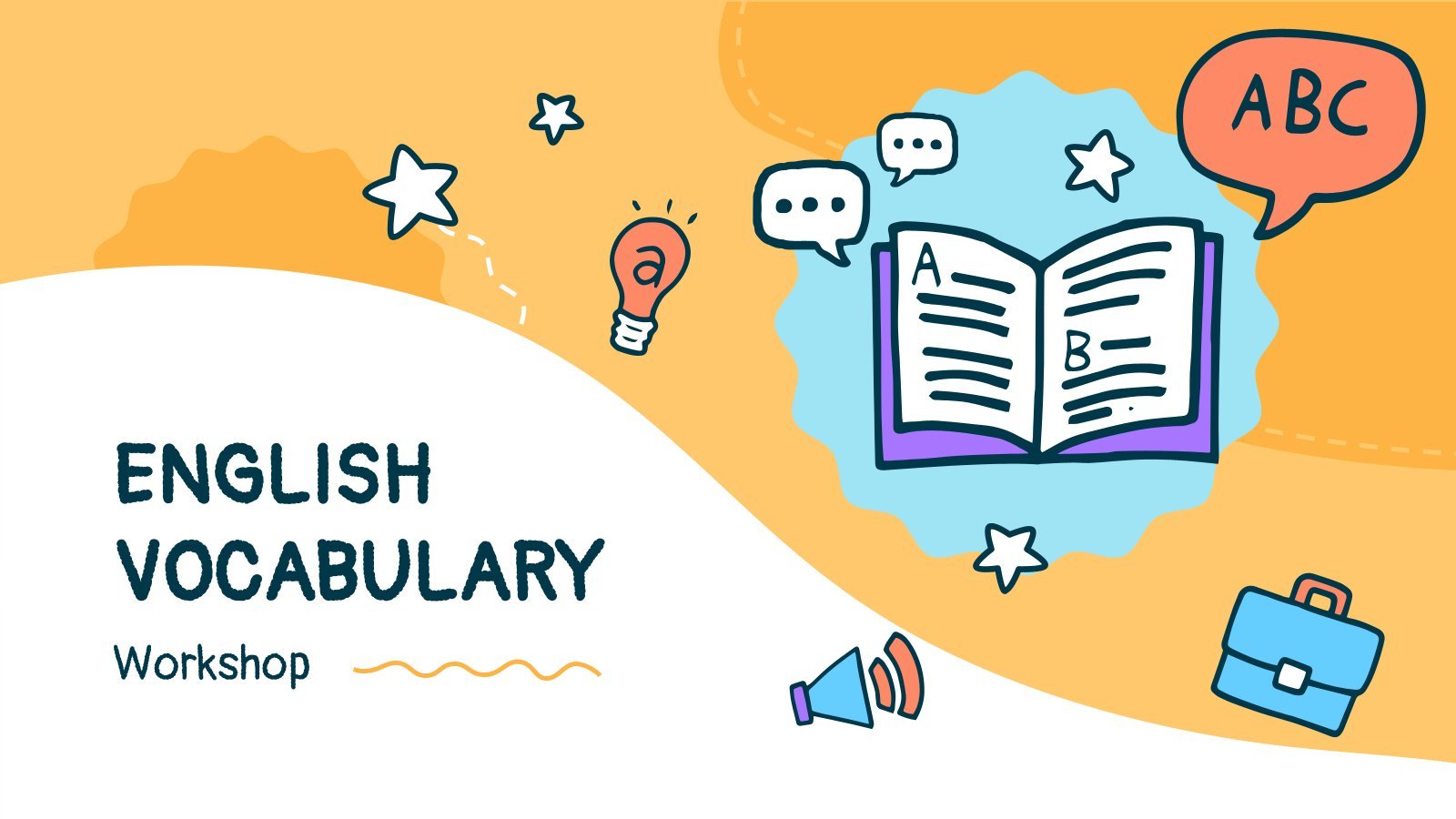
English Vocabulary Workshop
Teaching new words to your students can be a very entertaining activity! Create a vocabulary workshop with this presentation adorned with doodles, wavy shapes and different hues of yellow. Review the objectives, methodology, analysis and conclusions using pie charts, maps or tables.

English Language Arts Thesis
Some abstract shapes on the background are always a nice touch. The ones you’ll see in this template are quite colorful, as well as the infographics and the resources included to help you explain your methodology, study, results and conclusion of your thesis on English Language Arts.

Premium template
Unlock this template and gain unlimited access
English Modal Verbs Infographics
There is one thing you SHOULD try. It WILL help you prepare your lessons and CAN make the contents easier to understand. We are speaking about this set of infographic designs about English modal verbs! They are a MUST for English teachers and its creative and editable design WON’T let...

Creative Writing - Bachelor of Arts in English
Download the "Creative Writing - Bachelor of Arts in English" presentation for PowerPoint or Google Slides. As university curricula increasingly incorporate digital tools and platforms, this template has been designed to integrate with presentation software, online learning management systems, or referencing software, enhancing the overall efficiency and effectiveness of student...

Language Arts Subject for Middle School - 7th Grade: Comprehension
Most people know how to read, but do they understand what they read? That's a different story! But don't worry, you are a teacher and you know what to do! Start customizing this new template for education and share the secrets of a good reading comprehension with your students. Well,...

18th-Century Literature - Master of Arts in English
Download the "18th-Century Literature - Master of Arts in English" presentation for PowerPoint or Google Slides. As university curricula increasingly incorporate digital tools and platforms, this template has been designed to integrate with presentation software, online learning management systems, or referencing software, enhancing the overall efficiency and effectiveness of student...

Classic English Novels
Ah, literature, what a beautiful art. Are you an expert on classic novels written by English authors? Go back to the past with this template and tell your audience all about these best sellers that made an impact. Let the vintage look of the slides set the right tone and...

English Verbs Conjugation Infographics
This is the ultimate template for English teachers! This set of infographics has all the resources you need so that your students master all 12 verb tenses. They are so easy to use that they will alleviate the TENSion of preparing the lessons, and your students will be PERFECT English...

Grammar Lesson
Noam Chomsky, the great linguist, once said that “language is a process of free creation” with fixed laws and principles, although one can use these laws freely. Learn and teach more about how grammar works with this vintage template!
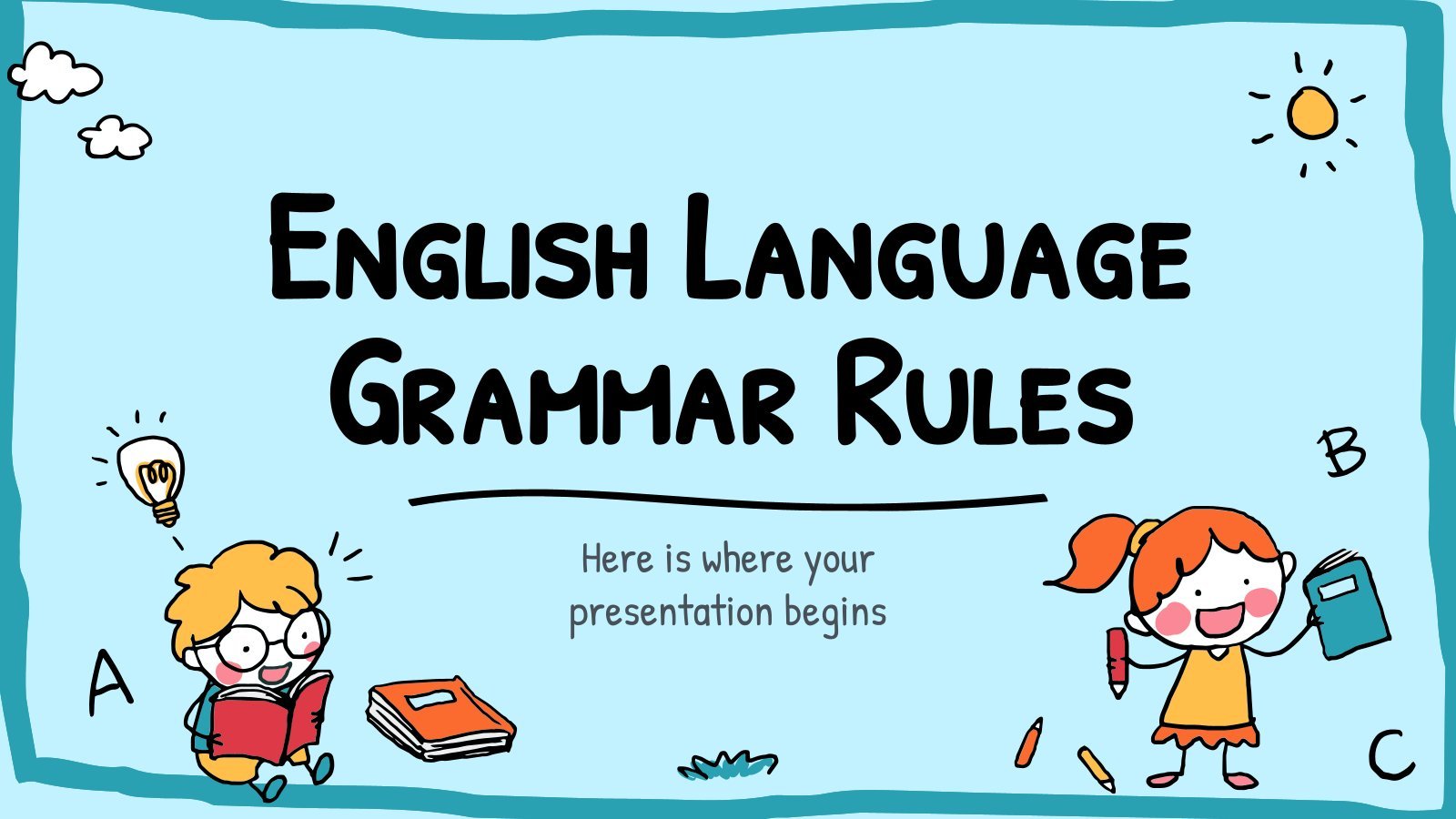
English Language Grammar Rules
The English language is spoken almost anywhere in the world, making it almost a necessity in everyone's education. Today, we're releasing this kid-friendly template with cute cartoony drawings of kids and many layouts prepared for you to teach some grammar rules. We've added some examples as a starting point. Use...

Language Arts Subject for High School - 9th Grade: Comparing Texts
Comparing texts and identifying their differences is a captivating exercise. Especially, if you teach your students how to do it with this elegant template. Novels, poems, autobiographies, descriptive texts… none of them will resist you after you practise the skills you’re going to learn with this presentation! It has lots...

English Literature Class
Open your books and your mind, the class is about to begin! What is there to know about English literature? Well, everything! Sit and enjoy a lesson about the history of literature, the best works, the most famous writers or go into detail and learn what made them so special....

Legal English Workshop
Is English legal? Or is it legal English? This play-on-words is not very good, unlike our new template for workshops! This design combines dark blue backgrounds with different geometric arrangements, which serve as decoration. It also uses a typography for titles that looks very unique—it's aim is to get your...

Renaissance Literature - Master of Arts in English
Download the "Renaissance Literature - Master of Arts in English" presentation for PowerPoint or Google Slides. As university curricula increasingly incorporate digital tools and platforms, this template has been designed to integrate with presentation software, online learning management systems, or referencing software, enhancing the overall efficiency and effectiveness of student...

Victorian Literature - Master of Arts in English
Download the "Victorian Literature - Master of Arts in English" presentation for PowerPoint or Google Slides. As university curricula increasingly incorporate digital tools and platforms, this template has been designed to integrate with presentation software, online learning management systems, or referencing software, enhancing the overall efficiency and effectiveness of student...

English Academy
Your academy fulfills a very important task: that of teaching English to the participants of the society of the future. It's time for you to give it a big boost and promotion using this fun illustrated template to talk about your teaching method, academic areas, teachers and the enrollment process...

Literary Criticism - Master of Arts in English
This elegantly designed template is a treasure for bibliophiles. Unveiling the path to mastering the fine art of literary criticism, this presentation will make your classes engaging and fascinating. It takes you on a journey of textual exploration, brought to life by beautifully floral illustrations sprinkled throughout the slides. From...

Gender and Literature - Doctor of Philosophy (Ph.D.) in English
Download the "Gender and Literature - Doctor of Philosophy (Ph.D.) in English" presentation for PowerPoint or Google Slides. As university curricula increasingly incorporate digital tools and platforms, this template has been designed to integrate with presentation software, online learning management systems, or referencing software, enhancing the overall efficiency and effectiveness...
- Page 1 of 7
New! Make quick presentations with AI
Slidesgo AI presentation maker puts the power of design and creativity in your hands, so you can effortlessly craft stunning slideshows in minutes.

Register for free and start editing online
Universities add Taylor Swift courses for students to live out their 'Wildest Dreams'
by PAIGE BARNES | WKRC

CINCINNATI (WKRC) — Universities in Ohio and Kentucky have entered their "Swiftie Era" by combining all things Taylor Swift and academia.
Professors at the University of Cincinnati (UC) and Northern Kentucky University (NKU) have worked to make typical subjects more relatable to students.
College students can fulfill their "Wildest Dreams" by taking a class on Taylor Swift and earning college credit.
Swift's latest album, "The Tortured Poets Department," provided even more content for NKU professor Donelle Dreese.
Dreese will teach English 394: The Poetry of Taylor Swift.
She's a great writer because she's a great reader. In a lot of interviews, she talks about being influenced by Emily Dickinson, Charlotte Bronte, and Shakespeare," said Dreese, an English professor.
Dreese said the course will have students study poets and their influence on Swift, but also look at the star as a poet herself.
"It's hard to choose a favorite Taylor Swift song, right? That's really hard to do. There are so many good ones," said Dreese.
At UC, Professor Melissa Jacquart showed philosophy will never go out of "Style" with her class, Philosophy: Taylor's Version.
Jacquart said each of Swift's eras brings up themes such as love, revenge and friendship.
There are many different philosophical theories about love. Is it the kind of thing you should understand as like an intimate relationship where you care about somebody? Or is it always this constant war and battle," said Jacquart.
To make sure there's no "Bad Blood" between her and the new students, anyone taking the course will get a friendship bracelet.
It's part of the culture that's piquing even non-Swifties interest.
"I do think it's kind of cool just to see the impact she's made around the world and how many fans she has. That's cool. And just to learn about it, and maybe learn from her about stuff," said Lucy Hurles, a UC second-year finance student.
So if students have a "Blank Space" in their schedule, Katie Monthie hopes students will take her class "Topics in Writing Studies: Taylor Swift."
"I think we neglect to recognize that there is importance to examining the everyday in a very serious academic manner. Sometimes, it also makes academic work more fun," said Monthie, an English Ph.D. student.
All three classes will be offered this fall so there's still room to sign up.
The professors are working on finalizing the course syllabus.

IMAGES
VIDEO
COMMENTS
ESL Presentation Topics: 12 Mini Presentations. ESL presentation topics for intermediate and upper intermediate students. Great as a warm-up or a speaking lesson. You can use the slideshow and share your screen on Zoom or other app when teaching online. Just click on the full screen option in the top right corner of the slideshow.
Presentation Projects for ESL/EFL Students. Over the years teaching in a Korean university, I've had students do plenty of presentation projects, with varying degrees of success. I hope that you can learn from my mistakes and make your ESL speaking classes as awesome as possible.
Establish audience rapport. Be aware of your body language. Understand cultural differences. Maintain interest by varying the speed, volume and pitch of your voice. Deal with listeners' questions politely. Respond to your audience positively. These tips are condensed from Presentations in English. Written by Josef Essberger for EnglishClub ...
Download FREE ESL PowerPoint lessons and use them in class today. These PowerPoint lessons are great to use in lessons teaching English to English language learners. You'll find vocabulary PowerPoints, grammar PowerPoints, seasonal grammar points, phonics PowerPoints, and more presentations covering the topics that ESL students typically study.
ESL presentation topics are a great way to learn English, build confidence, and learn about different cultures. They can be fun and rewarding for students of all levels. Beginners can start by sharing their daily routines and interests. It is a good way to practice using basic vocabulary and grammar in a fun way.
Pig Latin is a children's made-up language that is hundreds of years old. It shows up often in pop culture and media, a... 7 uses. A library of free English ESL ppt slides with listening, reading comprehension exercises, vocab + grammar practice activities made by teachers.
Presentations normally have one or more of the following aims: To inform/ raise awareness of an important issue. To persuade people to do something. Form part of an exam, demonstrating public speaking/presentation skills in a first or second language. I set students a task where they answer these questions:
Presentations. Give students a presentation of a topic of your choosing, perhaps your own hobby and model the format and language that you want the students to use. I tend to share slides with the student with the title of each slide already inserted. Students then have to fill the space with suitable information for that slide.
1. Have your students choose a topic of interest that would have several data points to research and present. 2. Have the students make a sketch of the planned infographic. 3. Using PowerPoint, have the students make the infographic (use a blank layout, in portrait, with the margins set to 10"/25cm by 30"/75cm). 4.
Check out these 29 TED talks for ESL students that can help you teach English in a fun and enjoyable way. These talks cover topics such as Greek mythology, studies on happiness and why we sleep, so your students can learn more about the world around them through an English-language lens. ... This presentation is under five minutes and tells the ...
ADVERBS OF FREQUENCY PPT. This Powerpoint presentation shows some flash cards and practice on adverbs and expressions of frequency. Hope is useful and fun for you and your students. :)) 60826 uses. A selection of English ESL ppt slides.
ESL Presentation Rubric. In-class presentations are a great way to encourage a number of English communicative skills in a realistic task that provides students not only help with their English skills but prepares them in a broader way for future education and work situations. Grading these presentations can be tricky, as there are many ...
7 Activities for Public Speaking That Will Boost ESL Students' Confidence. Public speaking can be a scary thing. Also known as glossophobia, the fear of public speaking is a major source of anxiety for roughly 75% of people worldwide.. However, public speaking is an essential skill everyone needs to have, including language learners.. The good news is that it gets easier with practice, which ...
Start with a polite welcome and state your name. Follow with your job title and/or the reason you're qualified to speak on the topic being discussed. 2. State the Purpose of Your Presentation. Now that your audience knows who you are and your qualifications, you can state the purpose of your presentation.
Research confirms that in order for ELLs to acquire English they must engage in oral language practice and be given the opportunity to use language in meaningful ways for social and academic purposes (Williams & Roberts, 2011). Teaching students to design effective oral presentations has also been found to support thinking development as "the ...
Business. In this lesson about business presentations in English, students discuss presentation structures in depth, watch a video with tips on giving presentations, and learn useful words and phrases related to the topic. The lesson is the first of the three-part series of lessons about delivering presentations. Unlimited Plan Show.
Personal online tutoring. EnglishScore Tutors is the British Council's one-to-one tutoring platform for 13- to 17-year-olds. Giving an oral presentation as part of a speaking exam can be quite scary, but we're here to help you. Watch two students giving presentations and then read the tips carefully.
10 Ideas for Teaching ESL Presentation Skills. 1. Practice Is the Answer. ... 6 Tips to Help ESL Students Give Killer Oral Presentations 0 75,087 0. Speaking. Teaching ESL Presentation Skills. How to Structure an Excellent Presentation. 0 41,312 0. Teaching Ideas. Lesson Planning for Beginners.
The lesson includes vocabulary development and a presentation activity which can be extended to include preparation of slides with visual aids. Students should prepare and practise their presentation as homework and deliver it in another lesson. The materials also include an optional extension activity relating to what can go wrong with a ...
This is a interactive powerpoint presentation about telling the time. It contains some flash cards and a multiple choice game. There are analog and digital clocks. 49321 uses. A selection of English ESL ppt slides with adults.
For careers, students would need to find out salaries, duties, top hiring companies, needed skills, and required certifications. When your students complete their research, students should deliver an oral presentation alongside their multimedia slideshow. Try one of ESL Library's new ready-made project-based learning modules.
We've organized these presentation topics for students by subject so you can easily browse through and find what you're looking for. Each section also comes with a bonus presentation template! We've also included some tips on designing a presentation once you've chosen a topic. For example, a flowchart data widget can help with a historic ...
Download the "Gender and Literature - Doctor of Philosophy (Ph.D.) in English" presentation for PowerPoint or Google Slides. As university curricula increasingly incorporate digital tools and platforms, this template has been designed to integrate with presentation software, online learning management systems, or referencing software, enhancing ...
College students can fulfill their "Wildest Dreams" by taking a class on Taylor Swift and earning college credit. Swift's latest album, "The Tortured Poets Department," provided even more content for NKU professor Donelle Dreese. Dreese will teach English 394: The Poetry of Taylor Swift. She's a great writer because she's a great reader.